
DIGITAL VOICE
RECORDER
USER MANUAL
Thank you for purchasing an Olympus digital voice recorder.
Please read these instructions for information about using the product
correctly and safely.
Keep the instructions handy for future reference.
To ensure successful recording, we recommend that you test the record
function and volume before use.
Getting started
Recording
Playback
Menu
Use with a PC
Other information
EN
1
2
3
4
5
6
VP-10

2
EN
Names of parts ............................................................................ 4
Recorder ................................................................................................4
Display .................................................................................................. 5
1 Getting started
Setup .......................................................................................... 6
Inserting the battery............................................................................. 7
Turning the power ON ........................................................................... 8
Setting the inserted battery ................................................................. 8
Setting the date/time ...........................................................................9
Charging the battery by connecting to a PC’s USB connector ............10
Charging the battery by connecting to an AC adapter with a USB
connection (model A514) ...................................................................11
Batteries....................................................................................13
Turning the power OFF ...............................................................15
Turning the power OFF .......................................................................15
2 Recording
Recording ..................................................................................16
Basic recording procedure ...................................................................16
Using earphones .................................................................................19
Selecting the automatic recording setting [Rec Scene] ................20
Selecting the automatic recording setting [Rec Scene] ...................... 20
Changing the information screen during recording .....................22
Changing the information screen during recording ........................... 22
3 Playback
Playback ....................................................................................23
Basic playback procedure .................................................................... 23
Fast-forwarding .................................................................................. 24
Rewinding .......................................................................................... 24
Skipping to the beginning of a file ..................................................... 25
Selecting the automatic playback operation [Play Scene] ............27
Selecting the automatic playback operation [Play Scene] .................27
Changing the playback speed .....................................................28
Changing the playback speed .............................................................28
Index marks/temp marks ...........................................................29
Writing an index mark/temp mark ..................................................... 29
Erasing an index mark/temp mark .....................................................29
Preventing accidental operation ................................................30
Setting HOLD mode ............................................................................30
Releasing HOLD mode ........................................................................30
Changing the information screen during playback or stop ...........31
Changing the information screen during playback or stop ................. 31
Searching for a file [Date Search] ................................................32
Using the date search function ...........................................................32
Erasing files ...............................................................................33
Erasing files ......................................................................................... 33
4 Menu
Setting menu items ...................................................................35
Basic operation ...................................................................................35
File menu [File Menu] .................................................................37
Preventing accidental file erasure [File Lock]......................................37
Dividing files [File Divide] ...................................................................37
Displaying file information [Property] ...............................................37
Recording menu [Rec Menu] .......................................................38
Selecting the recording sensitivity [Rec Level] ................................... 38
Setting the recording mode [RecMode].............................................38
Reducing noise caused by rubbing during recording [Anti-Rustle] ....39
Reducing noise during recording [Low Cut Filter]...............................39
Voice-activated recording function [VCVA]......................................... 39
Playback menu [Play Menu]........................................................41
Reducing noise during playback [Noise Cancel] .................................41
Adjusting low volume portions during playback [Voice Balancer] ..... 41
Specifying the range to play back [Playback Range] .......................... 41
Setting the repeat playback [Repeat] ................................................. 42
Setting a skip space [Skip Space] ........................................................ 42
Changing the folder for playback [Play Folder] ..................................43
LCD/Sound menu [LCD/Sound] ....................................................44
Setting the backlight [Backlight] ........................................................44
Adjusting the contrast [Contrast] ........................................................ 44
Setting the LED indicator light [LED] ..................................................44
Turning beeping sound ON/OFF [Beep] ..............................................44
Selecting the speaker output [Speaker] .............................................45
Playing the beginning of files automatically [Intro Play] ...................45
Device menu [Device] .................................................................46
Setting auto power off mode [Power Off] ..........................................46
Setting the recording standby duration
[Rec Standby] ............................. 46
Setting the battery in use [Battery] ....................................................46
Setting the date/time [Time & Date] ................................................. 47
Restoring the default settings [Reset Settings] ..................................48
Formatting the internal memory [Format].........................................48
Checking the internal memory information [Memory Info.] .............. 49
Confirming the voice recorder information [System Info.] .................49
Table of contents

3
EN
Table of contents
Dividing files [File Divide] ...........................................................50
Dividing files [File Divide] ...................................................................50
Changing the folder for playback [Play Folder] ............................52
Changing the folder for playback [Play Folder] ..................................52
Formatting the internal memory [Format] ..................................54
Formatting the internal memory [Format].........................................54
5 Use with a PC
PC operating environment .........................................................56
PC connection/disconnection ......................................................58
Connecting the voice recorder to a PC.................................................58
Disconnecting the voice recorder from a PC ........................................60
Loading a file to a PC ..................................................................61
Usage as external memory of the PC ...........................................63
Listening to files transferred from a PC .......................................64
To listen a transferred file....................................................................64
6 Other information
Alarm message list .....................................................................66
Troubleshooting ........................................................................68
Other .........................................................................................71
Recorder care ......................................................................................71
Accessories (optional) ......................................................................... 71
Copyright and trademark information ........................................72
Safety precautions .....................................................................73
Specifications ............................................................................77
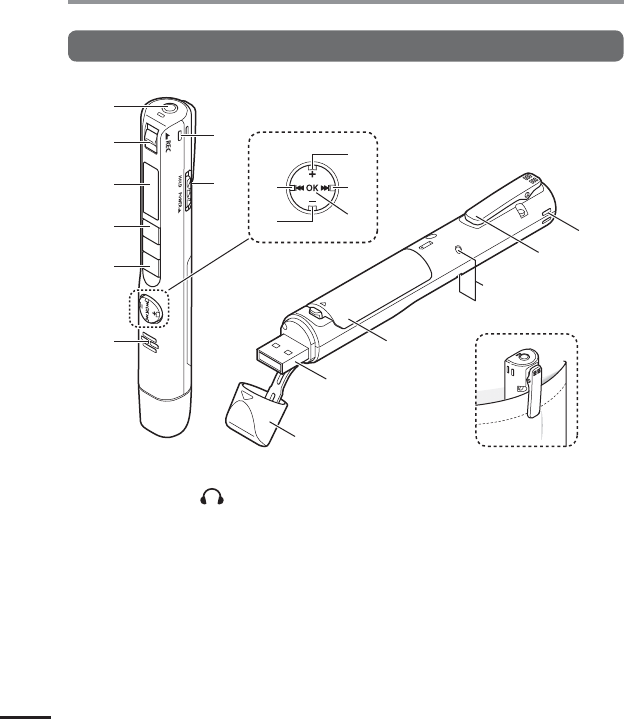
Names of parts
4
EN
Recorder
1
7
8
$
%
^
&
*
(
!
#
@
9
0
2
3
4
5
6
1 Earphone jack ( )
2
REC
(record) switch
3 Display
4
MENU
/
SCENE
button
5 `
PLAY
/4
STOP
button
6 Built-in speaker
7 Built-in stereo microphone (R)
8
POWER
/
HOLD
switch
9 0 button
0
–
button
!
+
button
@ 9 button
#
OK
button
$ Built-in stereo microphone (L)
% Clip
^ LED indicator light (LED)
& Battery cover
* USB connector
( USB connector cover
Names of parts

Names of parts
5
EN
Names of parts
Display
4 During recording
1 2 43
1 Ba
ttery (☞ P.12)
2 Voice recorder status indicator
[ ]: Recording (☞ P.16)
[
]: VCVA recording stand-by (☞ P.39)
[
]: Stop
[
]: Playback (☞ P.23)
[
]: Playback pause (☞ P.23)
[
]: Fast forward (☞ P.24)
[
]: Fast rewind (☞ P.24)
[
]: Fast playback (☞ P.28)
[
]: Slow playback (☞ P.28)
3 Elapsed recording time
4 Current file number in folder/Total
number of recorded files in folder
4 During stop or playback
65 7 8 9
5
File length/Elapsed playback time
6 Playback range (☞ P.41)
7 Repeat
8 File lock (☞ P.37)
9 Playback folder
(when [
Music
] folder is selected)
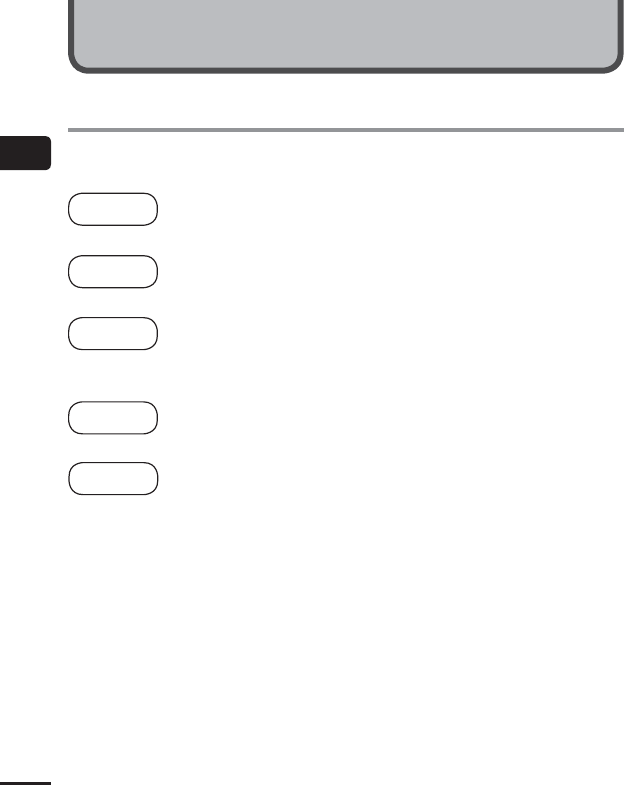
1
Setup
6
EN
Setup
After unpacking the voice recorder, follow the steps below to have it ready for use.
Step
1
3
Inserting the battery
Step 2
3
Turning the power ON
Step 3
3
Selecting the battery setting
Select the battery setting to match the inserted battery. Select the setting
for a nickel-metal hydride rechargeable battery or the setting for an alkaline
battery.
Step
4
3
Setting the date/time
Set the voice recorder’s clock for use with file management.
Step
5
Charging the recorder
Getting started
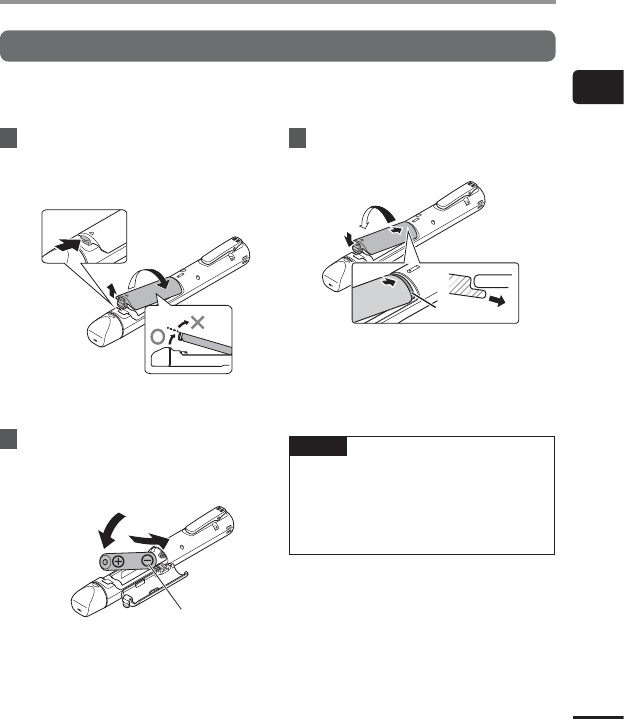
1
Setup
7
EN
Setup
Inserting the battery
Before using the voice recorder, insert the battery in the battery compartment of the voice
recorder.
1
Open the battery cover while
pressing the cover lock knob in
the direction of the arrow.
1
2
3
a
a Do not attempt to open the battery
cover by force.
2
Insert an AAA battery, making
sure its positive and negative
terminals are placed correctly.
2
1
Insert the battery’s
negative terminal first.
3
Close the battery cover until it is
completely closed.
1
3
2
b
c
Cross section
b Tab
c When attaching the cover, slide the
tab of the battery cover under the
outer shell of the recorder.
NOTE
• Be sur
e to firmly close the battery
cover (close until the battery cover lock
clicks).
• Be sure to charge the battery before
you start recording.
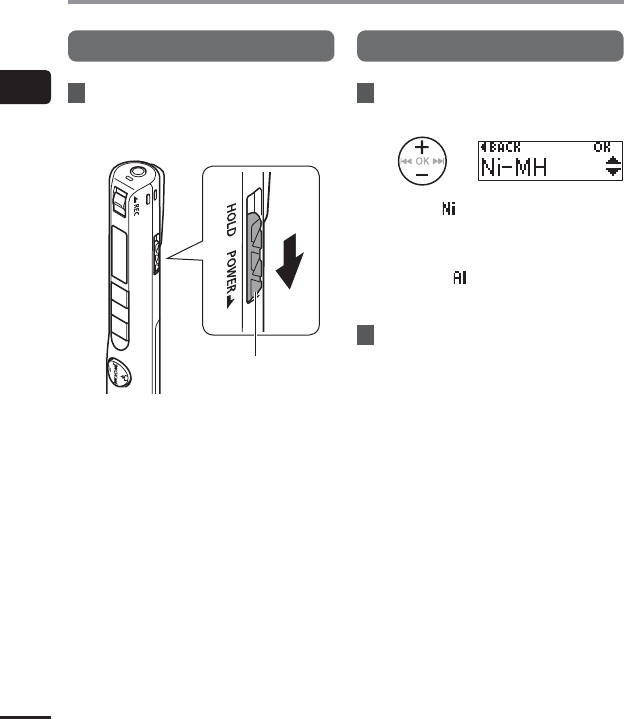
1
Setup
8
EN
Setup
Turning the power ON
1
While the voice recorder is turned
off, slide the
POWER
/
HOLD
switch
in the direction of the arrow.
POWER/HOLD switch
Setting the inserted battery
1
Press the
+
or
–
button to select
the type of battery you inserted.
[Ni-MH] ( )
Select if you inserted an Olympus
nickel-metal hydride rechargeable
battery (model BR404).
[Alkaline] (
)
Select if you inserted an alkaline
battery.
2
Press the
OK
button to finalize
the setting.
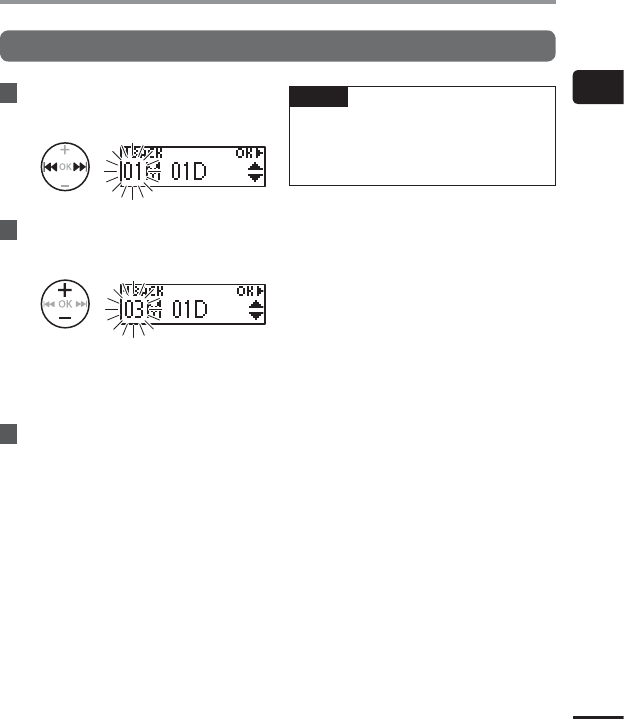
1
Setup
9
EN
Setup
Setting the date/time
1
Press the 9 or 0 button to
select the item to set.
2
Press the
+
or
–
button to change
the number.
• To change the setting of another item,
press the 9 or 0 button to move
the blinking cursor, then press the + or
– button to change the number.
3
Press the
OK
button to finalize
the setting.
TIP
• Y
ou can change the clock display
format. See “Setting the date/time
[Time & Date]” (☞ P.47) for the
procedure.
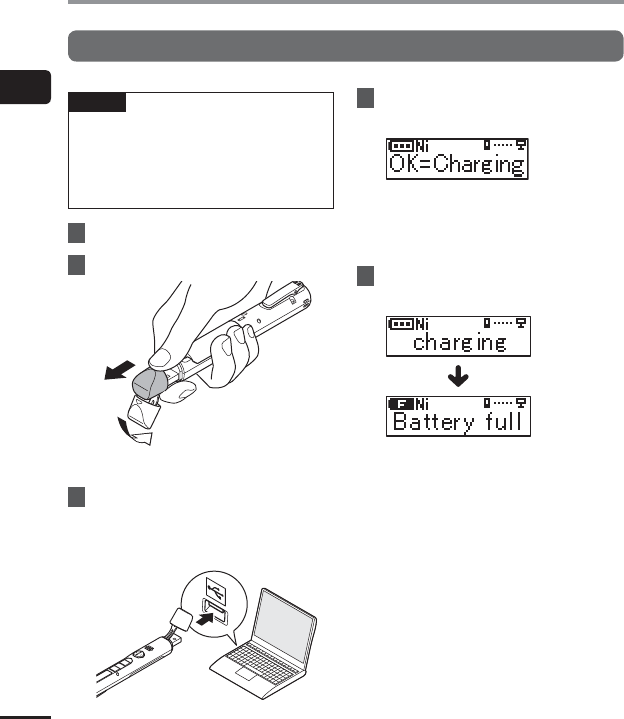
1
Setup
10
EN
Setup
Charging the battery by connecting to a PC’s USB connector
NOTE
• Bef
ore charging the battery, insert the
rechargeable battery provided and set
[Battery] to [Ni-MH].
• Before connecting the USB connector,
release HOLD mode (☞P.30).
1
Start the PC.
2
Remove the USB connector cover.
1
2
Slide open the USB connector cover using the
pad of your finger.
3
After making sure the voice
recorder is stopped, connect the
USB connector to a USB port on a
PC.
4
Press the
OK
button to start
charging.
• Press the OK button while this
message is blinking.
• The LED indicator light lights while
charging.
5
Charging has finished when
[
Battery full
] appears.
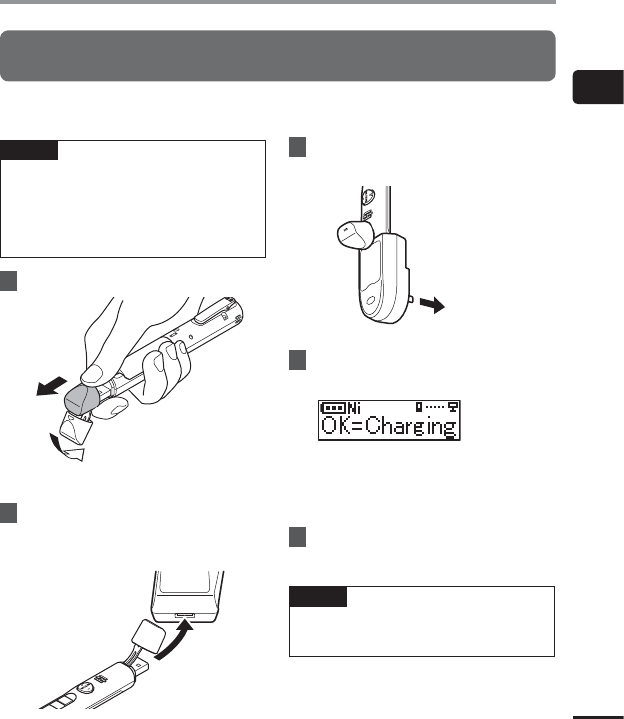
1
Setup
11
EN
Setup
Charging the battery by connecting to an AC adapter with a USB connection
(model A514)
The battery can be recharged by connecting the recorder to the provided AC adapter (A514).
NOTE
• Bef
ore charging the battery, insert the
rechargeable battery provided and set
[Battery] to [Ni-MH].
• Before connecting the AC adapter,
release HOLD mode (☞P.30).
1
Remove the USB connector cover.
1
2
Slide open the USB connector cover using the
pad of your finger.
2
Connect the voice recorder to
the USB connector on the AC
adapter.
To USB connector
of AC adapter
(model A514)
3
Connect the AC adapter to an AC
power outlet.
To an AC power
outlet
4
Press the
OK
button to start
charging.
• Press the OK button while this
message is blinking.
• The LED indicator light lights while
charging.
5
Charging has finished when
[
Battery full
] appears.
NOTE
• U
se only the Olympus USB connecting
AC adapter model provided (A514).
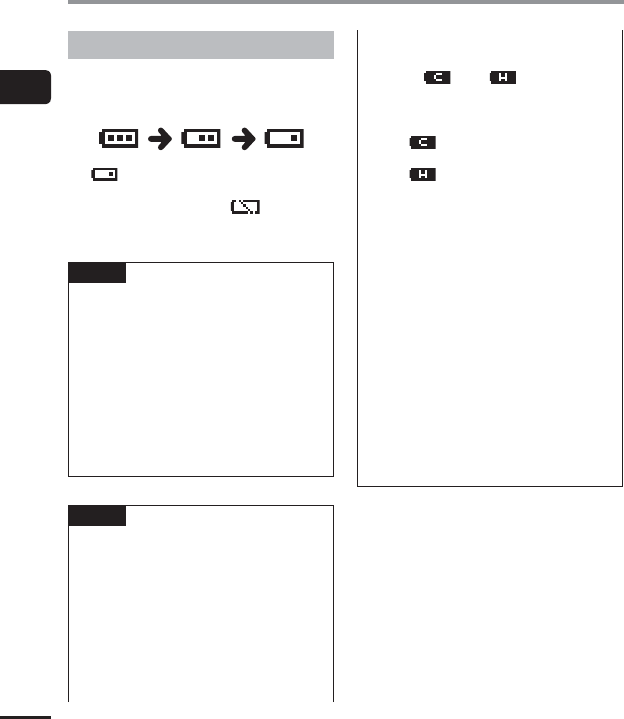
1
Setup
12
EN
Setup
Battery indicator
As the battery loses its remaining charge, the
battery indicator on the display changes as
follows:
• [ ] indicates there is little remaining
battery charge. Charge the battery. When
the battery has run out, [
] and
[Battery low] appears, operation stops.
TIP
• Char
ging the recorder, release the
HOLD mode. While the recorder is in
HOLD mode, any button operations are
disabled (☞P.30).
• Charging time: About 3 hours*
* Approximate time needed to fully
charge a completely flat battery at
room temperature.
The charging time depends on the
amount of remaining power and the
state of the battery.
NOTE
• Nev
er attempt to charge an alkaline
battery, lithium battery or other
primary cell battery. Fluid leakage or
overheating may cause the recorder to
malfunction.
• The power of PC must be ON to charge
the battery using the USB connector.
You cannot charge the battery when
the power of PC is OFF, or the PC is in
standby, sleep or auto power off mode.
• Do not use a USB hub when charging
the battery by connecting to the PC.
• When [
]
*1
or [ ]
*2
is displayed
the battery cannot be charged. Charge
the battery in an ambient temperature
of between 5 and 35°C (41 and 95°F).
*1 [
]: Ambient temperature is too
low.
*2 [
]: Ambient temperature is too
high
• If battery life has become noticeably
short on a full charge, replace the
battery with a new one.
• Insert the USB connector securely all
the way. Operation will not be normal if
the connection is not made properly.
• Use the USB extension cable provided
if needed.
• Use only a compatible Olympus USB
extension cable. Operation is not
guaranteed if another manufacturer’s
cable is used. Only use the Olympus
USB extension cable with the voice
recorder and never use if a product
from another manufacturer is used.
• Use only the Olympus USB connecting
AC adapter model provided (A514).

1
Batteries
13
EN
Rechargeable batteries
Read the information below carefully when
using a nickel-metal hydride rechargeable
battery (model BR404).
4 Discharging
Rechargeable batteries discharge naturally
when not in use. Be sure to charge the
battery before use.
4 Operating temperature
Rechargeable batteries are chemical-based
products. Their performance can vary
even when used within the recommended
operating temperature range. This variation
is normal.
4 Recommended temperature
range
When powering voice recorder: 0 to 42°C
(32 to 107.6°F)
When being charged: 5 to 35°C (41 to 95°F)
During long-term storage: –20 to 30°C
(–4 to 86°F)
Use of a rechargeable battery outside the
temperature ranges above may result in
drops in battery performance or life. When
not using the voice recorder for an extended
period, remove the rechargeable battery
before storage to prevent fluid leakage or
rust.
Batteries
NOTE
• T
he voice recorder does not support
manganese batteries.
• When replacing the battery, use an AAA
alkaline dry cell battery or an Olympus
nickel-metal hydride rechargeable
battery (model BR404). Operation is not
guaranteed. If a battery from another
manufacturer is used.
• The [Battery] screen appears
automatically after you have replaced
the battery. You can also use a menu
operation to display this screen and set
the battery (☞ P.47). After replacing
the battery, turn on the power and
then make sure you set the settings on
the [Battery] screen and [Time & Date]
screen before recording.
• You may need to reset the date/time
if the battery is removed from the
voice recorder for over one minute,
or if the battery is quickly removed
and replaced. See “Setting the date/
time [Time & Date]” (☞ P.47) for the
procedure.
• Due to the nature of nickel-metal
hydride rechargeable batteries, new
batteries and batteries not used for an
extended period (one month or more)
may not charge completely. The battery
should become fully charged after
charging and discharging the battery
up to three times.
• Always dispose rechargeable batteries
in the legally prescribed manner. Before
disposing rechargeable batteries that
are not fully discharged, take steps to
prevent shorting such as insulating
their terminals with tape.
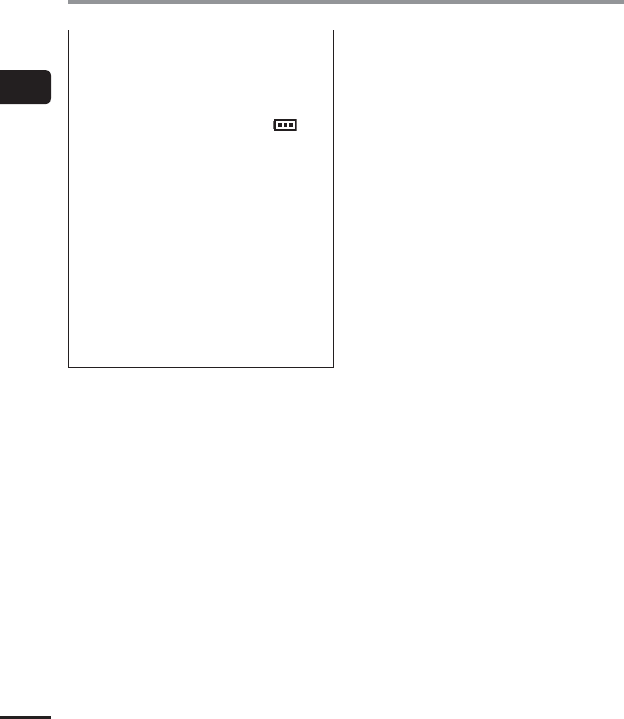
1
Batteries
14
EN
Batteries
• Always turn power off before replacing
the battery. Files may be damaged if
the battery is removed while the voice
recorder is recording or performing an
operation such as erasing a file.
• Even if the battery indicator is [
],
playback with the built-in speaker at
some volumes may result in a drop
in battery output voltage, causing
the voice recorder to reset. Lower the
volume in this case.
• The continuous battery usage time of
a nickel-metal hydride rechargeable
battery that has been used repeatedly
will be reduced due to battery
degradation (☞ P.78).
• Battery life will be shorter when using
a nickel-metal hydride rechargeable
battery that has been used repeatedly
(☞ P.78).
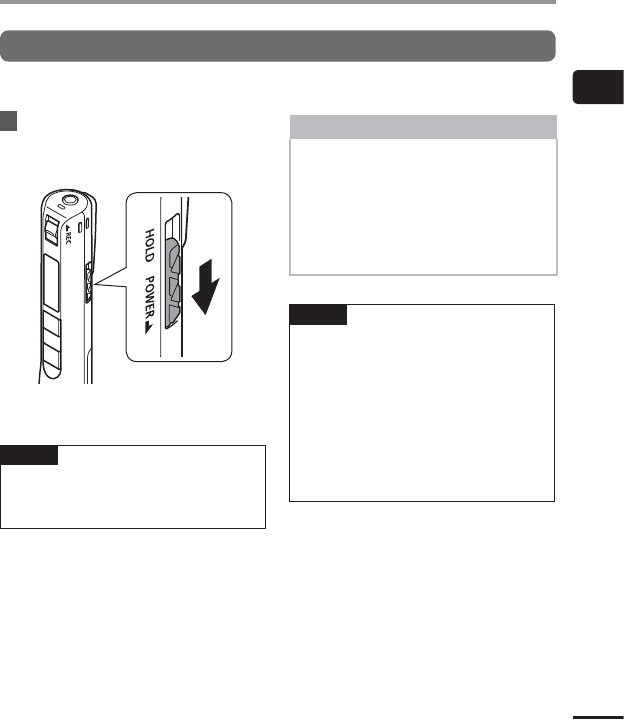
1
Turning the power OFF
15
EN
Turning the power OFF
Existing data, mode settings and the clock setting are saved when the power is turned OFF.
1
Slide the
POWER
/
HOLD
switch in
the direction of the arrow for at
least 0.5 seconds.
• The playback stop position at power
OFF is stored in the memory.
TIP
• T
urning the power OFF whenever the
voice recorder is not in use minimizes
battery consumption.
Auto power off mode
When the voice recorder has been
stopped for at least 5 minutes (default
setting) after power ON, the display
disappears and the voice recorder
automatically turns off (☞P.46).
• To reuse the voice recorder, turn the
power ON again.
NOTE
• T
he voice recorder will not be turned
off during recording, even if the
POWER/HOLD switch operated.
• If the [Rec Standby] function is
enabled, the voice recorder will remain
in recording standby state even after
the power is turned off so the battery
will deplete more quickly. Once the
time set for [Rec Standby] elapses, the
power turns off completely (☞P.46).
Turning the power OFF
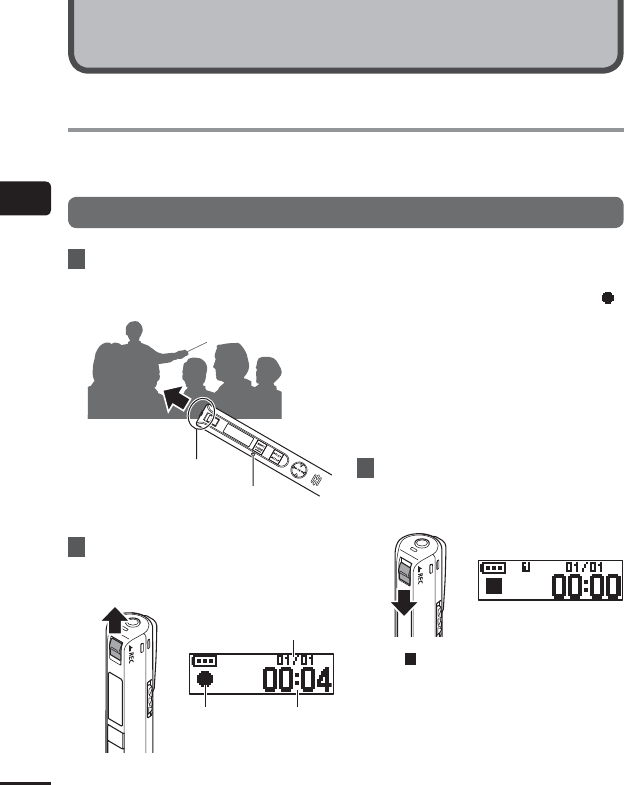
2
Recording
16
EN
Recording
Even if a recording opportunity suddenly arrises, you can start recording from the power off
state. Up to 999 recordings can be made.
Basic recording procedure
1
Point the built-in microphone
in the direction of the sound to
record.
Built-in stereo
microphone
LED indicator
light
2
Slide the
REC
switch to start
recording in the direction of the
arrow.
a
bc
a Current file number in folder/Total
number of recorded files in folder
b Recording indicator
c Elapsed recording time
• The LED indicator light lights, and [
]
appears in the display.
• After replacing the battery, turn on the
power and then make sure you set the
settings on the [Battery] screen and
[Time & Date] screen before recording.
• If you record simple recording content
at the beginning, it will be convenient
for searching later using the [Date
Search] function (☞ P.32).
3
Slide the
REC
switch to stop
recording in the direction of the
arrow.
• [ ] appears in the display.
Recording

2
Recording
17
EN
Recording
Sound files recorded with the voice
recorder are automatically given a file
name in the format below.
VP100001 .MP3
12
1 File number
File numbers are assigned
consecutively.
2 Extension
A file extension indicating the
recording format the file was recorded
in by the voice recorder.
• Linear PCM format: “.WAV”
• MP3 format: “.MP3”
• WMA format: “.WMA”
TIP
• When r
ecording with the voice recorder
in a pocket or alike, secure it with a clip
to prevent if from moving.
• Even if recording starts during
playback of a file in the [Music] folder,
the recorded file will be saved in the
[Recorder] folder (☞P.52).
NOTE
• T
o prevent the beginning of the
recording being cut off, start recording
after the LED indicator light has lit or
mode indicator has appeared in the
display.
• When the remaining possible recording
time is 60 seconds, the LED indicator
light starts flashing. It flashes more
rapidly as the remaining time decreases
(at the 30- and 10-second points).
• When [Folder full] appears, no more
recording can be done. You will need to
delete unneeded files to record more
(☞P.33, P.66).
• If [Memory full] appears, the voice
recorder has no more available
memory space. You will need to
delete unneeded files to record more
(☞ P.33, P.66).
• Processing performance may
be reduced when data has been
repeatedly written to or deleted from
the recording media. Please initialize
the recording media in this case
(☞P.54).
• This voice recorder can record only with
the built-in microphone. An external
microphone cannot be connected.
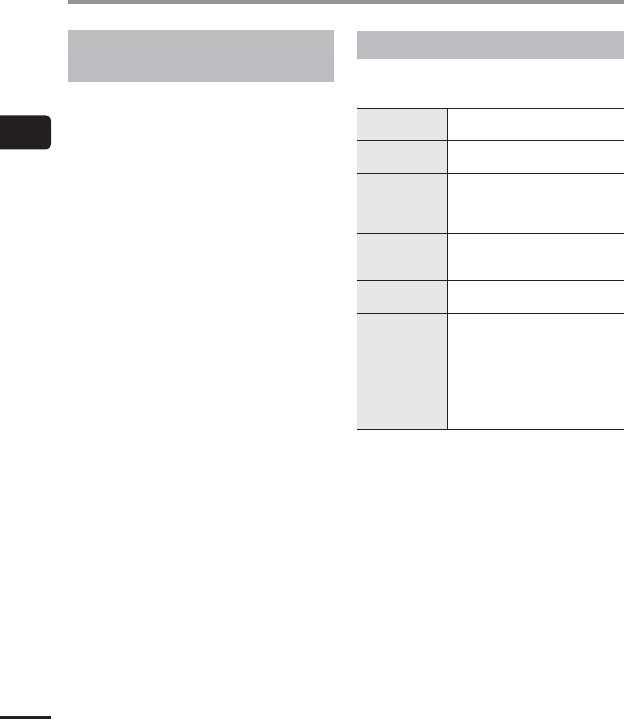
2
Recording
18
EN
Recording
Recording linear PCM format data over
2 GB
When recording a linear PCM format file,
recording will continue even after the file size
exceeds 2 GB.
• The data is divided and saved in separate
files of up to 2 GB. The files are processed
as multiple files during playback.
• After recording 999 files which exceed 2GB
recording stops.
Recording settings
For various recording conditions, different
recording settings are available.
[
Rec Level
]
(☞ P.38)
Sets the recording sensitivity.
[
Rec Mode
]
(☞ P.38)
Sets the recording sound quality.
[
Anti-Rustle
] *
(☞ P.39)
Reduce noise caused by the
voice recorder rubbing against
clothing (rustling sounds) when
recording in your pocket.
[
Low Cut Filter
]
(☞ P.39)
Reduces humming sounds
from equipment such as air-
conditioners or projectors.
[
VCVA
]
(☞ P.39)
Sets the trigger level for voice-
activated recording (VCVA).
[
Rec Scene
]
(☞ P.20)
Used to select one of multiple
preregistered templates of
recording settings. When
selected, each template enters
several settings tailored to a
particular recording location
or condition all in a single
operation.
* When recording with the voice recorder in a
pocket or alike, secure it with a clip to prevent if
from moving.
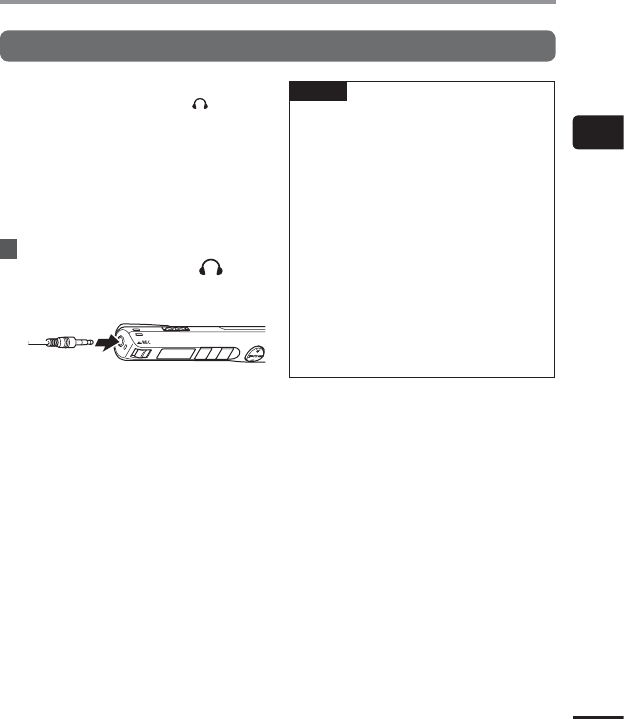
2
Recording
19
EN
Recording
Using earphones
If you connect commercially available
earphones to the earphone jack (
) of the
voice recorder, you will be able to listen to the
audio during recording and playback.
• Use the +/– button to adjust the recording
monitor volume.
• Earphones are not supplied with this
product.
1
Connect the earphones to the voice
recorder’s earphone jack ( ).
To earphone jack
• Changing the volume will not affect
the recording level.
• There will be no sound from the
speaker when the earphones are
connected.
NOTE
• T
o avoid unpleasantly loud sound, set
the volume to [00] before plugging in
the earphone.
• To prevent feedback, do not place the
earphone near the microphone while
recording.
• Avoid excessive volume when listening
to playback through the earphones. It
may cause hearing damage or loss.
• Battery life depletes quickly while
recordings are monitored. To conserve
battery life, leave the earphone
disconnected while recording.
• If the [Anti-Rustle] function (☞ P.39)
is enabled, you may sound like an echo
during monitoring the recording.
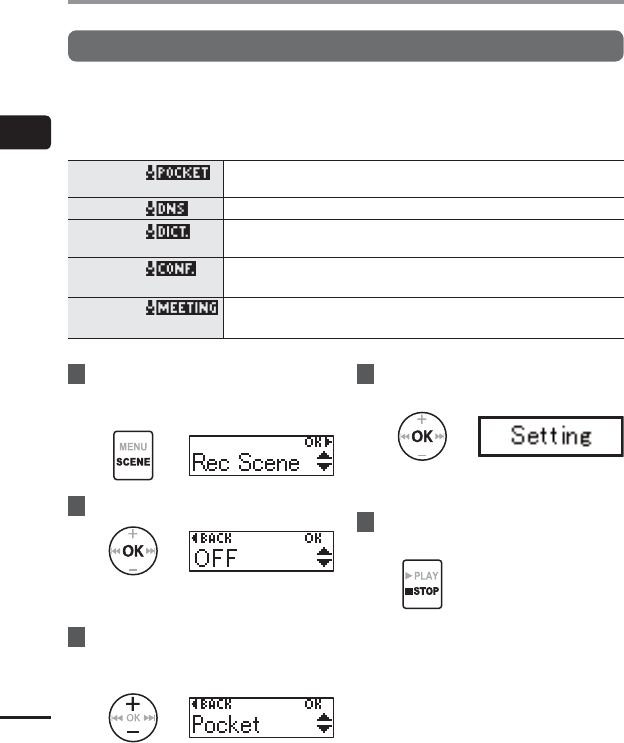
2
Selecting the automatic recording setting [Rec Scene]
20
EN
Selecting the automatic recording setting [Rec Scene]
The voice recorder has preregistered templates of optimum settings tailored to various
recording applications such as conference and dictation. When selecting one of these
templates you can enter several settings recommended for your recording application all in a
single operation.
[
Pocket
] Suitable for recording sounds over a wide area while the voice recorder is still
in your pocket.
[
DNS
] For Speech Recognition Software.
[
Dictation
] Suitable for recording your own voice and other sounds that are extremely
close.
[
Conference
] Suitable for recording conferences in a large space and other sounds over a
wide area.
[
Meeting
] Suitable for recording meetings held in a small space and other sounds that
are fairly close.
1
While the voice recorder is in stop
mode, press and hold the
MENU
/
SCENE
button.
2
Press the
OK
button.
• Press the 0 button to return to the
previous screen.
3
Press the
+
or
–
button to
select the desired recording
application.
4
Press the
OK
button to finalize
the setting.
• According to the setting, the setting
icon is displayed.
5
Press the `
PLAY
/4
STOP
button to
exit the menu screen.
• See "Preregistered [Rec Scene]
settings" for more information
(☞ P.21).
Selecting the automatic recording setting [Rec Scene]
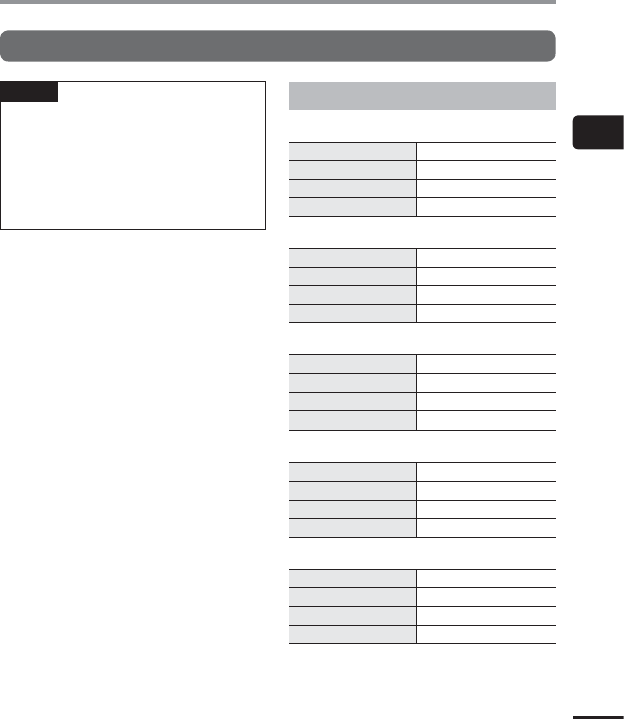
2
Selecting the automatic recording setting [Rec Scene]
21
EN
Selecting the automatic recording setting [Rec Scene]
Selecting the automatic recording setting [Rec Scene]
NOTE
• When a r
ecording scene is selected,
recording-related menu settings
cannot be used in combination with
the recording scene. If you attempt to
use any of those functions, the [Rec
Scene] setting will be automatically set
to [OFF].
Preregistered [Rec Scene] settings
[
Pocket
]:
[
Rec Level
][
High
]
[
Rec Mode
][
MP3 128k ST
]
[
Anti-Rustle
][
High
]
[
Low Cut Filter
][
OFF
]
[Dictation]:
[
Rec Level
][
Low
]*
[
Rec Mode
][
MP3 128k ST
]
[
Anti-Rustle
][
Low
]
[
Low Cut Filter
][
ON
]
[
Conference
]:
[
Rec Level
][
High
]
[
Rec Mode
][
MP3 128 kbps
]
[
Anti-Rustle
][
OFF
]
[
Low Cut Filter
][
ON
]
[
Meeting
]:
[
Rec Level
][
High
]
[
Rec Mode
][
MP3 128k ST
]
[
Anti-Rustle
][
Low
]
[
Low Cut Filter
][
OFF
]
[
DNS
]:
[
Rec Level
][
Low
]*
[
Rec Mode
][
MP3 128k ST
]
[
Anti-Rustle
][
OFF
]
[
Low Cut Filter
][
OFF
]
* The recording sensitivity is set to a level that is
even lower than [Low].
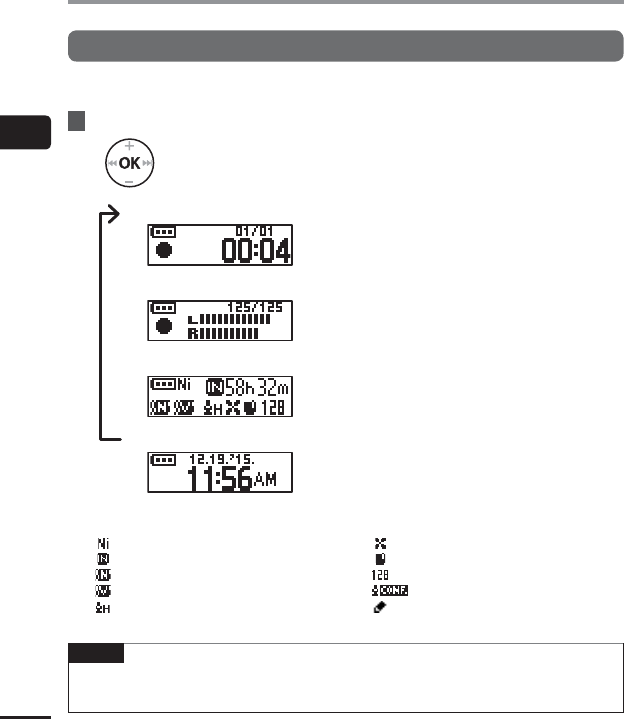
2
Changing the information screen during recording
22
EN
Changing the information screen during recording
Changing the information screen during recording
You can change the information screen during recording.
1
While the voice recorder is in recording mode, press the
OK
button.
• Each press of the OK button changes the information screen.
1 Elapsed recording time screen (default screen)
You can display the elapsed recording time and
current file number in folder.
2 Recording level meter screen
The meter changes according to recording volume
and recording function setting.
3 Functions indicator screen
You can display the indicator of functions and
remaining recording time.
4 Date and time screen
You can display the current date and time.
4 Meanings of indicators (same for all modes)
[ ]: Battery type (☞P.46)
[
]: Possible recording time
[
]: Noise Cancel (☞P.41)
[
]: Voice Balancer (☞P.41)
[
]: Rec Level (☞P.38)
[
]: Low Cut Filter (☞P.39)
[
]: Anti-Rustle (☞P.39)
[
]: Rec Mode (☞P.38)
[
]: Rec Scene (☞P.20)
[
]: Play Scene (☞P.27)
NOTE
• T
he information screen return to default screen if the voice recorder will be changed to
other operation (stop, playback, recording).

3
Playback
23
EN
Playback
In addition to files recorded by the voice recorder, you can also play files in WAV, MP3 and WMA
format transferred from a PC.
Basic playback procedure
1
Press the 0 or 9 button to
select the desired playback file.
ab
a Current file number in folder/Total
number of recorded files in folder
b File length
TIP
• T
he file length display appears for
3 seconds.
• You can search for voice files by
specifying a recording date
(☞ P.32).
2
Press the `
PLAY
/4
STOP
button to
start playback.
dc
c Playback indicator
d Elapsed playback time
• [
] appears in the display.
3
Press the
+
or
–
button to adjust
the volume to the desired level.
• The volume can be adjusted to a
setting between [00] to [30]. The
higher the number, the louder the
volume.
• If the volume is set too loud, a warning
screen may appear.
4
Press the `
PLAY
/4
STOP
button to
stop playback.
• [ ] appears in the display.
• The file being played stops right away.
The resume function automatically
stores the playback stop position in
memory. The position is retained even
if the power is turned OFF. The next
time the power is turned ON, playback
can be resumed from the stop position
stored in the memory.
Playback
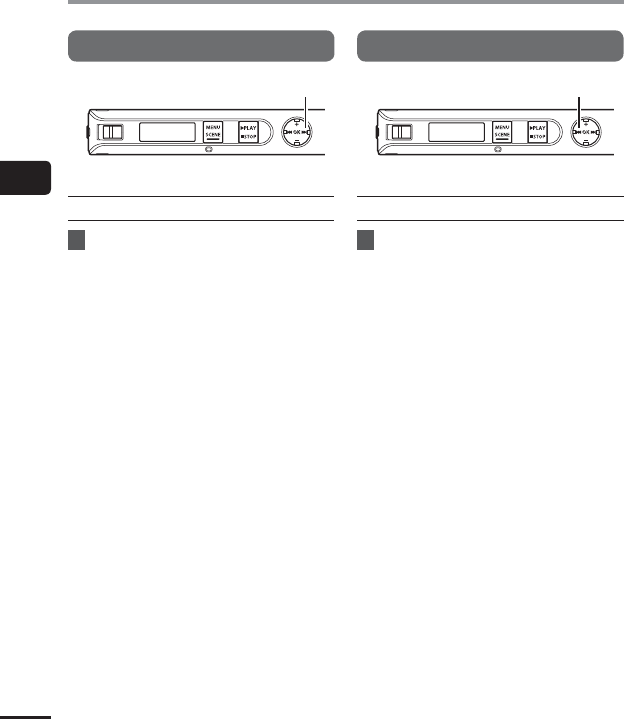
3
Playback
24
EN
Playback
Fast-forwarding
9 button
Fast-forwarding during playback
1
Press and hold the 9 button
during playback.
• Playback starts from the current
position when you release the 9
button.
• If an index mark or temp mark in the
file is reached, fast-forwarding stops at
the mark (☞ P.29).
• Fast-forwarding stops when the end
of the file is reached. Press and hold
the 9 button again to fast-forward
from the beginning of the next file.
Rewinding
0 button
Rewinding during playback
1
Press and hold the 0 button
during playback.
• Playback starts from the current
position when you release the 0
button.
• If an index mark or temp mark in the
file is reached, rewinding stops at the
mark (☞P.29).
• Rewinding stops when the beginning
of the file is reached. Press and hold
the 0 button again to rewind from
the end of the previous file.
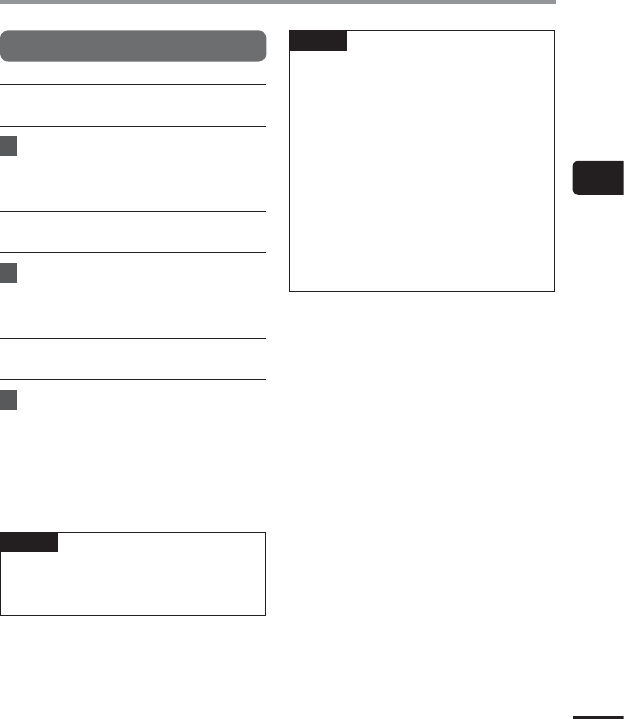
3
Playback
25
EN
Playback
Skipping to the beginning of a file
Skipping to the beginning of the
next file
1
Press the 9 button while the
voice recorder is in stop mode, or
during playback.
Skipping to the beginning of the
current file
1
While the voice recorder is in stop
mode or playing back, press the
0 button.
Skipping to the beginning of the
previous file
1
Press the 0 button when
the playback position is the
beginning of the file.
• To skip to the beginning of the
previous file during playback, press the
0 button twice consecutively.
TIP
• T
o skip the files continuously, pressing
the 0 or 9 button while the
recorder is in stop mode.
NOTE
• I
f an index mark or temp mark
is reached when skipping to the
beginning of a file during playback,
playback starts from the position of the
mark. When skipping to the beginning
of a file while the voice recorder is
in stop mode, the mark is ignored
(☞P.29).
• If a setting other than [File Skip]
is set for [Skip Space], playback
starts after the set amount of time
has been skipped backwards or
forwards. Playback does not skip to the
beginning of the file.
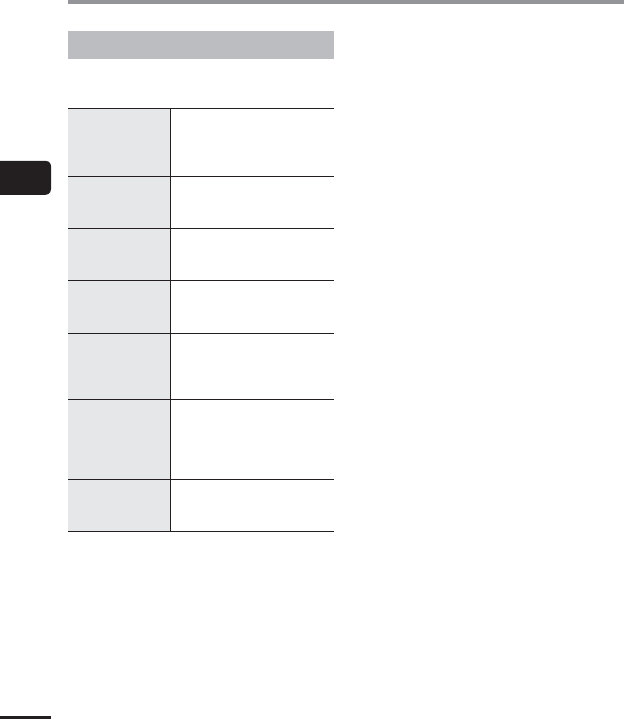
3
Playback
26
EN
Playback
Playback settings
You can select various file playback methods
tailored to different applications and tastes.
[
Noise Cancel
]*
(☞ P.41)
A setting that makes recorded
voices more discernable when
muffled by projector noise or
similar sounds.
[
Voice Balancer
]*
(☞ P.41)
Compensates low-volume
portions of recorded audio files
during playback.
[
Playback Range
]
(☞ P.41)
Selects whether to play back
individual files or all files in
a folder.
[
Repeat
]
(☞ P.42)
Repeatedly plays back the
range selected in [Playback
Range].
[
Skip Space
]
(☞ P.42)
A handy function for quickly
moving the playback position,
and playing short segments
repeatedly.
[
Play Scene
]
(☞ P.27)
Switches to the playback
operation setting. In this setting
transcription can be made
while listening to recorded
content.
[
Play Folder
]
(☞ P.52)
Use this when you wish to
switch to the [Recorder] folder
or another folder in [Music].
* This function is only available when a file in
the [Recorder] folder is selected.

3
Selecting the automatic playback operation [Play Scene]
27
EN
Selecting the automatic playback operation [Play Scene]
The beginning or end of the wrong file is never selected even when you perform the forward
or return operation repeatedly. You can also use the fast or slow playback function at the same
time.
[
Transcription
] This is convenient for creating the minutes and written records from audio files of
meetings, interviews, and other events where multiple people speak.
[
Language study
] This is convenient for playing back conversations and language study content
many times repeatedly.
1
While the voice recorder is in stop
mode, press and hold the
MENU
/
SCENE
button.
2
Press the
+
or
–
button to select
[
Play Scene
].
3
Press the
OK
button.
• Press the 0 button to return to the
previous screen.
4
Press the
+
or
–
button to select
the desired preset playback
settings package.
5
Press the
OK
button to finalize
the setting.
6
Press the `
PLAY
/4
STOP
button to
exit the menu screen.
• See "Preregistered [Play Scene]
settings" for more information
(☞P.36).
Selecting the automatic playback operation [Play Scene]
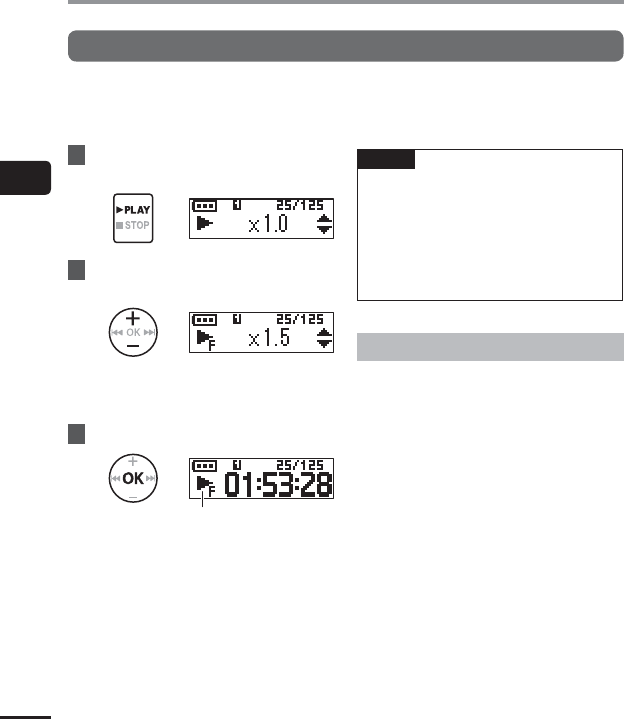
3
Changing the playback speed
28
EN
Changing the playback speed
You can change the playback speed. Changing the playback speed is handy for speeding
up conference presentations, or for slowing down parts difficult to discern when learning a
language.
1
Press and hold the `
PLAY
/4
STOP
button during playback.
2
Press the
+
or
–
button to select
the desired playback speed.
• You can set the playback speed from
[x 0.5] (slow) to [x 1.0] (normal) to
[x 2.0] (fast).
3
Press the
OK
button.
a
a Playback speed display
• To return to the normal playback
speed, set the setting to [x1.0].
NOTE
• Alt
ered playback speed settings are
retained even after power OFF.
• Changing the playback speed will make
the battery deplete more quickly.
• The function below cannot be used
when changing the playback speed.
• [Noise Cancel] (☞ P.41)
Fast playback restrictions
Depending on their sampling rate and bit
rate, some files may not play normally. In this
case you will need to reduce the playback
speed.
Changing the playback speed
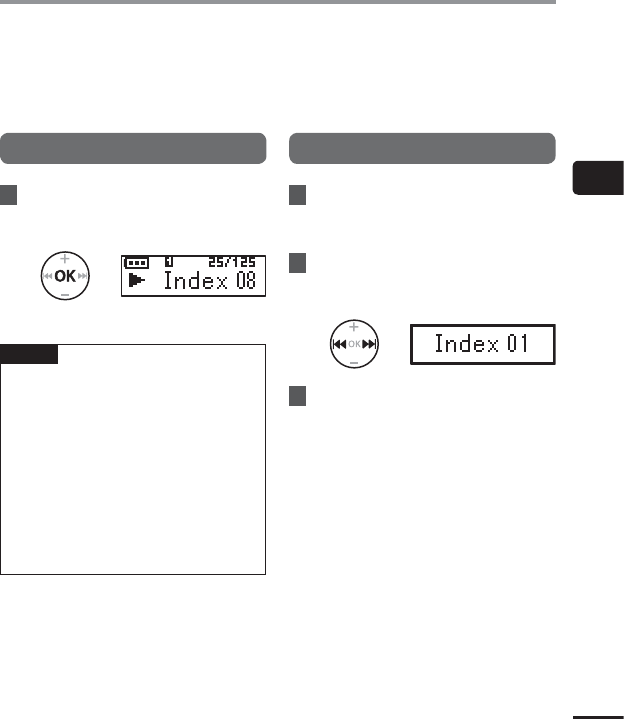
3
Index marks/temp marks
29
EN
Writing an index mark or temp mark in a file enables you to quickly access desired position in
the file with the same operations used for fast-forwarding, rewinding or skipping to the start of
a file. Index marks are added to the files created using Olympus voice recorders and temp marks
are added to files created using other devices. The position you wish to start listening from can
be temporarily stored in a file during playback.
Writing an index mark/temp mark
1
At the position to add an index
mark or temp mark, pr
ess and
hold the
OK
button.
NOTE
• T
emp marks are temporary markings.
They are automatically erased when
you select a different file, transfer the
file to a PC, or move the file on a PC.
• You can write up to 99 index marks/
temp marks in a single file. The
message [Index Full] appears if you
attempt to write more than 99 marks.
• You cannot write or erase index
marks/temp marks in files that have
been locked by the file lock function
(☞ P.37).
Erasing an index mark/temp mark
1
Select a file that contains index
mark/temp mark y
ou want to
erase and start playback.
2
Use the 9 or 0 butt
on to
select the index mark/temp mark
you want to erase.
3
When the number of the index
mark/temp mark to erase is being
shown (for about 2 seconds) in
the display, press and hold the
OK
button.
• Any subsequent index marks/temp
marks in the file are automatically
renumbered.
Index marks/temp marks
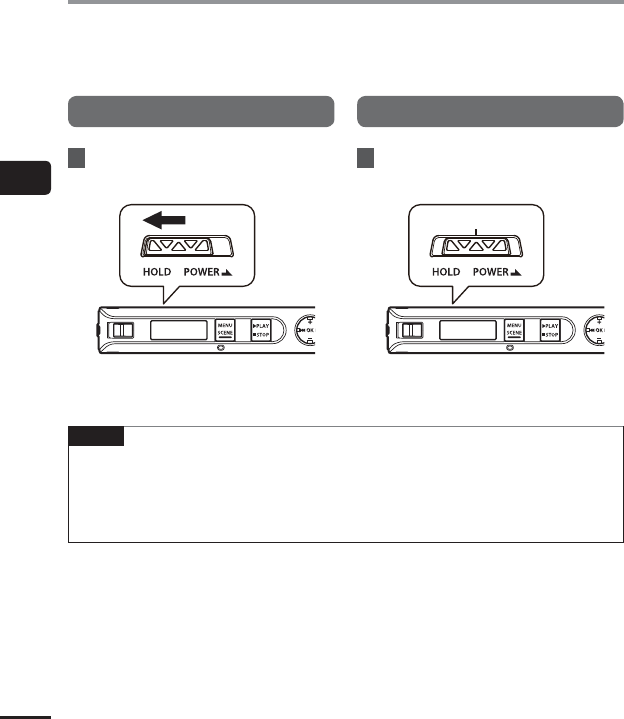
3
Preventing accidental operation
30
EN
Setting the voice recorder to HOLD mode maintains the current operation and disables button
operations. HOLD mode is a handy feature for preventing unintentional operation from
accidental button presses when the voice recorder is carried in a bag or pocket.
Setting HOLD mode
1
Slide the
POWER
/
HOLD
switch to
the [
HOLD
] position.
• [Hold] appears in the display, and the
recorder enters HOLD mode.
Releasing HOLD mode
1
Slide the
POWER
/
HOLD
switch to
position A shown below.
a
NOTE
• When an
y button is pressed during HOLD mode, [Hold] appears in the display for 2
seconds. No other operation is performed.
• Setting HOLD mode during voice recorder playback continues the playback operation
and prevents any other operation from being performed (the voice recorder stops when
playback ends).
Preventing accidental operation
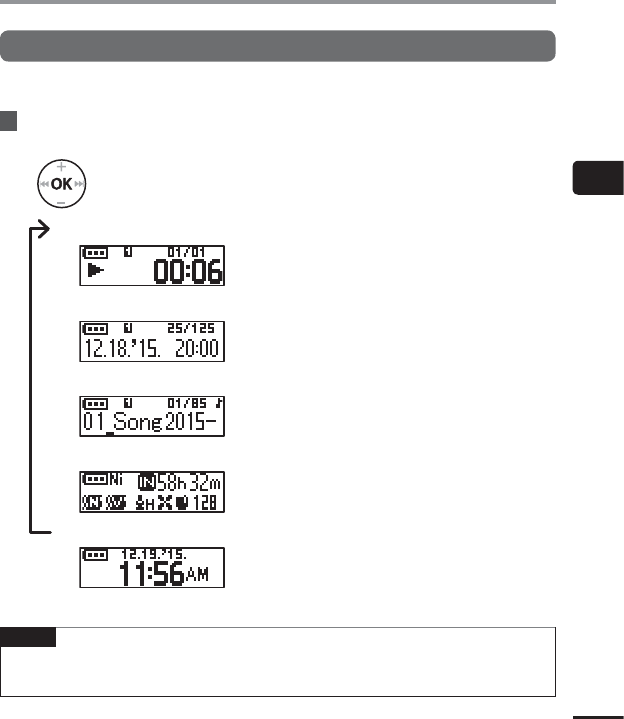
3
Changing the information screen during playback or stop
31
EN
Changing the information screen during playback or stop
You can change the information screen during playback or stop.
1
While the voice recorder is in playback mode or stop mode, press the
OK
button.
• Each press of the OK button changes the information screen.
1 Elapsed playback time screen (default screen)
You can display the elapsed playback time and
current file number in folder.
2 Recording time/date screen ([Recorder] folder is selected)
You can display the recording time and date of
current file.
File name screen ([Music] folder is selected)
You can display the name of current file.
3 Functions indicator screen
You can display the indicator of functions and
remaining recording time (☞ P.22).
4 Date and time screen
You can display the current date and time.
NOTE
• T
he information screen return to default screen if the voice recorder will be changed to
other operation (stop, playback, recording).
Changing the information screen during playback or stop
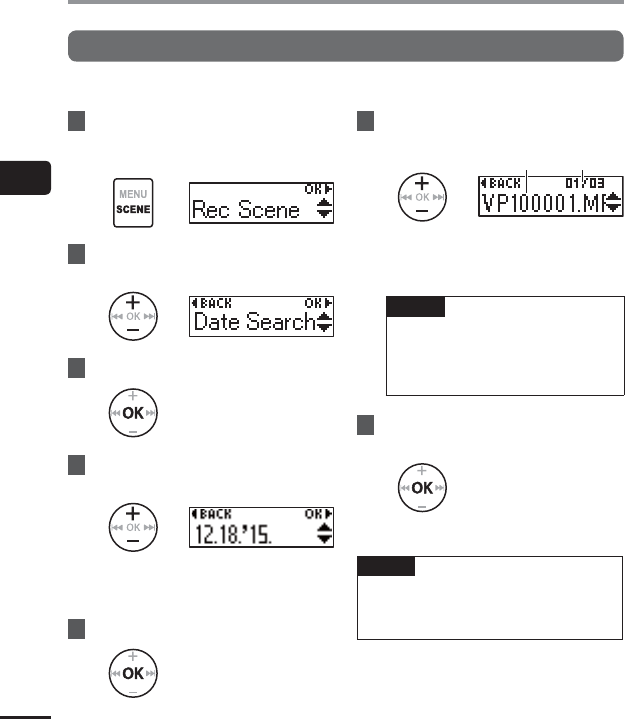
3
Searching for a le [Date Search]
32
EN
Using the date search function
You can search for voice files by specifying a recording date.
1
While the voice recorder is in stop
mode, press and hold the
MENU
/
SCENE
button.
2
Press the
+
or
–
button to select
[
Date Search
].
3
Press the
OK
button.
4
Press the
+
or
–
button to select
the desired recording date.
• All of the dates on which recordings
were made are displayed. Select the date
you are searching for from the dates.
5
Press the
OK
button.
6
Press the
+
or
–
button to select
the desired file.
ab
a File name
b File number/Number of files
registered for the selected date
TIP
• Each time y
ou select a file, the
voice recorder can automatically
play the beginning of the file for
10 seconds (☞ P.45).
7
Press the
OK
button to start
playback.
NOTE
• T
o perform a date search, you need
to set [Time & Date] in advance
(☞ P.47).
Searching for a file [Date Search]
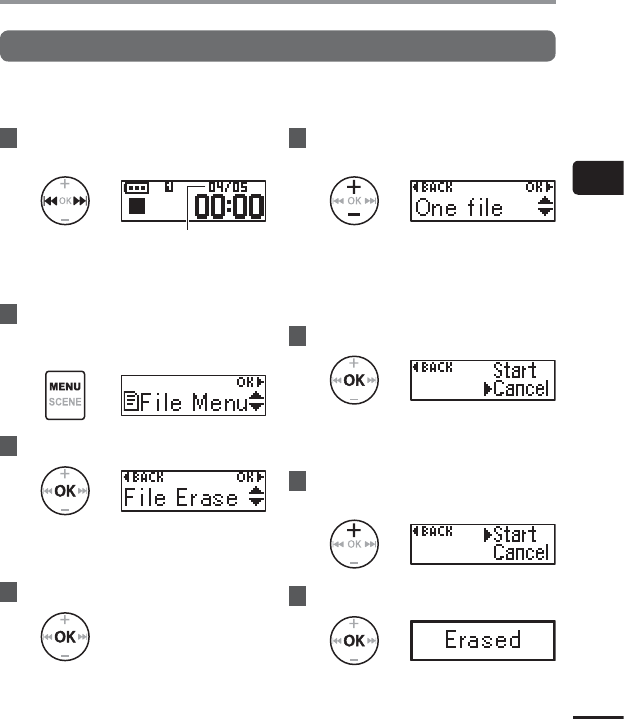
3
Erasing les
33
EN
Erasing files
This section describes how to erase a single unneeded file from a folder, erase all the files in the
current folder at once.
1
Press the 0 or 9 button to
select the file you want to erase.
The file of this number is
erased. After it is erased,
renumbering is performed
automatically.
2
While the voice recorder is in stop
mode
, press the
MENU
/
SCENE
button.
3
Press the
OK
button.
• The voice recorder returns to the
stopped mode if no operation is
performed for 3 minutes.
4
Press the
OK
button again.
5
Press the
+
or
–
button to select
[
One file
] or [
All in folder
].
[One file]:
Erases only the selected file.
[All in folder]:
Erases all the files saved in the same
folder as the selected file.
6
Press the
OK
button.
• If no operation is performed for 8
seconds during menu operation, the
previous screen is redisplayed.
7
Press the
+
button to select
[
Start
].
8
Press the
OK
button.
• [Erasing] appears in the display, and
the erasing process starts. [Erased]
appears when the process has finished.
Erasing files

3
Erasing les
34
EN
Erasing files
NOTE
• F
iles cannot be restored after being
erased, so please check carefully before
erasing a file.
• Locked files and read-only files cannot
be erased (☞
P.37).
• If there is a file that cannot be
recognized by the recorder, the file
will not be erased. The voice recorder
must be connected to a PC to erase
these files.
• Before erasing a file, charge or replace
the battery to ensure it will not run
out before the process has finished.
Erasing processes can take over 10
seconds to complete. To prevent the
risk of damage to data, never remove
the battery before an erasing process
has finished.

4
Setting menu items
35
EN
Setting menu items
Basic operation
The menus consist of the following five setting menus: [File Menu], [Rec Menu], [Play Menu],
[LCD/Sound], and [Device], which each provide useful functions to meet a variety of needs.
Follow the steps below to set a menu item.
1
Press the
MENU/SCENE
button
during recording, playback or
stop.
TIP
• S
ome menus contain items that
can be set during recording/
playback (☞P.36).
2
Press the
+
or
–
button to select
the setting menu containing item
you want to set.
3
Press the
OK
button.
• The setting item of the selected
setting menu is displayed.
• You can also use the 9 button to
perform this operation.
• Press the 0 button to return to the
previous screen.
4
Press the
+
or
–
button to select
the desired setting item.
5
Press the
OK
button.
6
Press the
+
or
–
button to change
the setting.
7
Press the
OK
button to finalize
the setting.
• A message indicating the setting has
been entered appears.
Menu
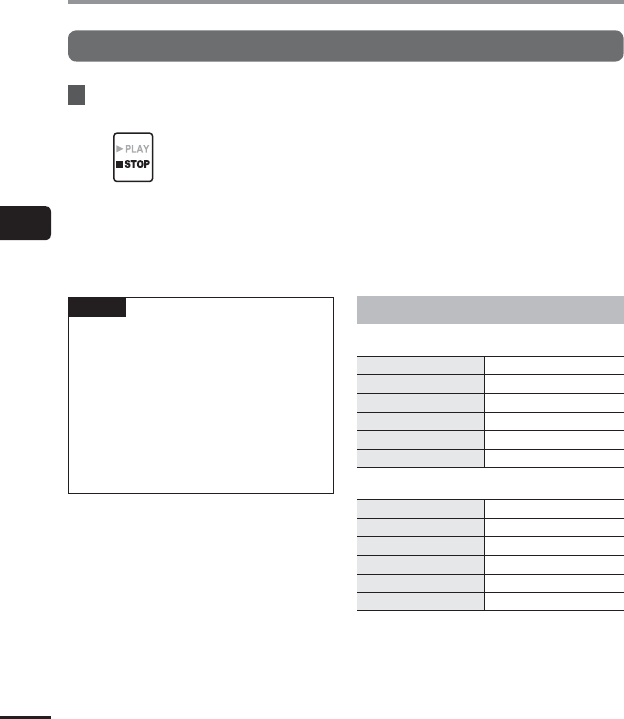
4
Setting menu items
36
EN
Setting menu items
Basic operation
8
Press the `
PLAY
/4
STOP
button to
exit the menu screen.
• When you enter the menu screen
during recording or playback, press
the MENU/SCENE button to return
to the previous screen without
interrupting recording or playback.
NOTE
• F
or menu settings done while the voice
recorder is in stop mode, the voice
recorder exits the menu and returns to
the stopped mode if no operation is
performed for 3 minutes. The selected
setting item is not changed in this case.
• For menu settings done during
recording/playback, the voice recorder
exits the menu if no operation is
performed for 8 seconds.
4 Menu items that can be set
during recording;
• Backlight
• LED
4 Menu items that can be set
during playback;
• Property
• Backlight
• LED
Preregistered [Play Scene] settings
[Transcription]:
[
STOP ( 4)
][
Auto Back (3 sec)
]*
[
9 (CUE)
][
x2.0 Play Back
]
[
0 (REV)
][
Reviewing
]
[
9 (SKIP)
][
10 sec. Skip
]
[
0 (SKIP)
][
3 sec. Skip
]
[
Voice Balancer
][
ON
]
[Language study]:
[
STOP ( 4)
][
Stop
]
[
9 (CUE)
][
x2.0 Play Back
]
[
0 (REV)
][
Reviewing
]
[
9 (SKIP)
][
10 sec. Skip
]
[
0 (SKIP)
][
3 sec. Skip
]
[
Voice Balancer
][
OFF
]
* If you press the `PLAY/4STOP button during
playback, the audio is rewound 3 seconds from
the position at which the button was pressed and
then stopped.

4
File menu [File Menu]
37
EN
File menu [File Menu]
Preventing accidental file erasure
[File Lock]
The file lock feature lets you lock important
files to prevent them being accidentally
erased. Once locked, a file is not erased even
if the operation for erasing all the files in its
folder is performed (☞ P.33).
1
Select the file you want to lock
(☞ P.23).
[ON]:
Locks the file.
[OFF]:
File lock is canceled.
Dividing files [File Divide]
Large files or files with long recording times
can be divided for easier management and
editing.
See “Dividing files [File Divide]” (☞P.50)
for the procedure.
Displaying file information
[Property]
You can display the information of a file from
a menu screen.
File information
1
Press the
+
or
–
button to switch
the screen.
• [Name] [Date] [Size] [Bit Rate]
*1
[Artist]
*2
[Album]
*2
are displayed.
*1 When a linear PCM format file is
selected, the sampling rate and bit
count are displayed in the [Bit Rate]
field.
*2 If there is no tag information in
the file, [UNKNOWN_ARTIST] and
[UNKNOWN_ALBUM] are displayed.
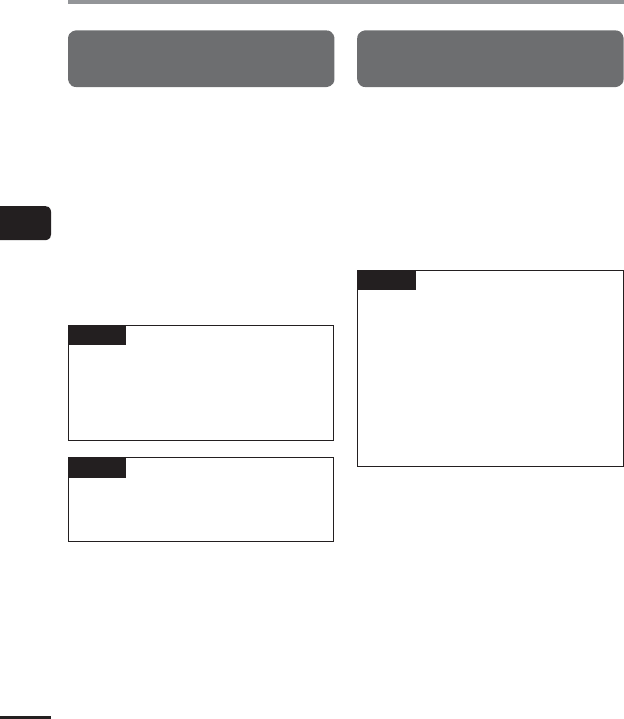
4
Recording menu [Rec Menu]
38
EN
Selecting the recording sensitivity
[Rec Level]
You can change the recording level
(sensitivity) as needed for your recording
application.
[High]:
The highest recording sensitivity.
Suited to recording lectures, large
conferences and other applications
with distant or quiet sound sources.
[Low]:
The lowest sensitivity, this level is
suitable for dictation.
TIP
• When y
ou wish to record a speaking
voice clearly, set [Rec Level] to [Low],
and place the voice recorder’s built-in
microphone near the speaker’s mouth
(5 to 10 cm away).
NOTE
• T
he recording level is adjusted
automatically. Excessively loud sound
input may generate noise.
Setting the recording mode
[RecMode]
You can prioritize sound quality or recording
time. Select the recording mode that best
matches your recording application.
[PCM]
[MP3 128k ST]
[WMA 32 kbps mono]
*
[WMA 5 kbps mono]
*
* Mono recording
TIP
• PCM f
ormat allows you to faithfully
record the original sound because
compression and other processing is
not performed, but the file size will
be large. Check that you have enough
remaining memory before recording.
• To record conferences and
presentations clearly, it is
recommended to set [Rec Mode]
setting to [MP3 128k ST].
Recording menu [Rec Menu]

4
Recording menu [Rec Menu]
39
EN
Recording menu [Rec Menu]
Reducing noise caused by rubbing
during recording [Anti-Rustle]
Reduce noise caused by the voice recorder
rubbing against clothing (rustling sounds)
when recording in your pocket.
NOTE
• When r
ecording with
the voice recorder in a
pocket or alike, secure it
with a clip to prevent if
from moving.
[High] [Low]:
Reduces noise caused by rubbing
sounds (rustling sounds) during
recording.
[OFF]:
Turns the rustling sound reduction
function off.
Reducing noise during recording
[Low Cut Filter]
The voice recorder’s low cut filter function
lets you make recordings that reduce
humming sounds from air-conditioners or
low-frequency sounds from equipment such
as projectors.
[ON]:
Turns the low cut filter ON.
[OFF]:
The low cut filter is disabled.
Voice-activated recording function
[ VCVA]
The voice-activated recording function
(VCVA) automatically starts recording when
a sound louder than a preset voice activation
level is detected, and automatically pauses
recording when the sound volume level
falls. Use this function to automatically omit
unneeded quiet segments when recording
(such as long silences during conferences),
saving memory.
[ON]:
Turns VCVA ON. You can adjust the
voice activation level used for VCVA.
[OFF]:
Turns VCVA OFF. Restores standard
recording.
Adjusting the voice activation level for
voice-activated recording
1
Slide the
REC
switch to start
recording.
• Recording pauses automatically
about 1 second after the input
sound becomes quieter than the set
activation sensitivity.
The LED indicator light becomes
lit when recording is activated and
flashes when recording is paused.
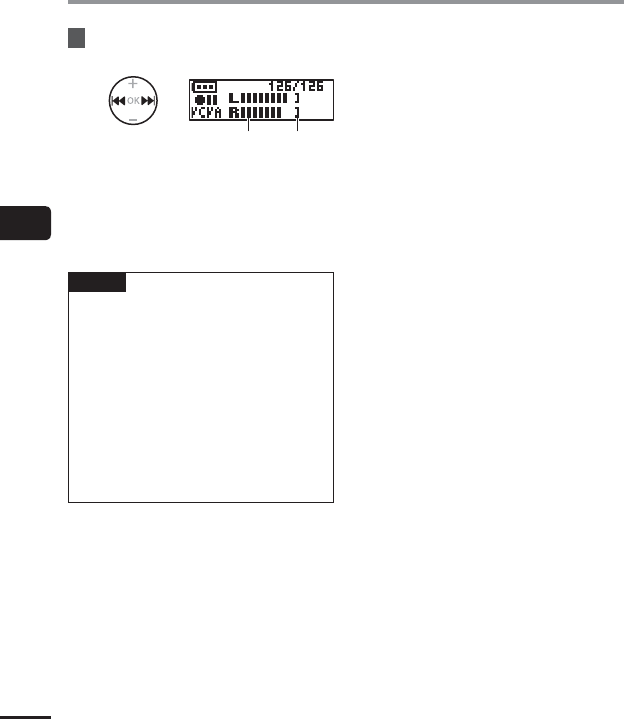
4
Recording menu [Rec Menu]
40
EN
Recording menu [Rec Menu]
2
Press the 9 or 0 button to
adjust the voice activation level.
ba
a Voice activation level (moves left/
right to match set level)
b Level meter (changes in proportion
to recording sound volume)
• The setting can be adjusted in 23
steps.
TIP
• Each pr
ess of the 0 button increases
the activation sensitivity level of VCVA,
and a high level will result in recording
starting even with small sounds.
• Adjust the VCVA voice activation level
to suit the recording conditions (to
cope with high levels of surrounding
noise or alike).
• To avoid recording mistake, it’s
recommended to perform a test
recording beforehand to adjust the
voice activation level.

4
Playback menu [Play Menu]
41
EN
Reducing noise during playback
[Noise Cancel]
Use the [Noise Cancel] function to reduce
noise when a recorded voice is difficult to
discern.
[High] [Low]:
Reduces surrounding noise to play
back clearer sound quality.
[OFF]: The noise cancel function is
disabled.
NOTE
• [Noise C
ancel] function is only
available when a file in the [Recorder]
folder is selected.
• If the [Noise Cancel] function is used,
the battery will deplete more quickly.
• The following function will not be
available while you are using the
[Noise Cancel] function.
• Changing the playback speed
(☞P.28)
Adjusting low volume portions
during playback [Voice Balancer]
The [Voice Balancer] function adjusts low-
volume portions of recorded audio files to
make them louder.
[ON]:
Adjusts low-volume portions of
audio files during playback, making
them louder.
[OFF]:
The voice balancer function is
disabled.
NOTE
• [V
oice Balancer] function is only
available when a file in the [Recorder]
folder is selected.
Specifying the range to play back
[Playback Range]
Select the playback range according to your
preference.
1
Press the
+
or
–
button to select
[
Recorder
] or [
Music
].
[Recorder]:
Set the playback range for playing files
recorded with the built-in microphone.
[Music]:
Set the playback range for playing files
transferred from a PC.
2
Press the
+
or
–
button to select
the setting.
[File]:
Stops playback after the current file
has been played.
[Folder]:
Plays all the files in the current folder
consecutively, stopping playback after
the last file in the folder is played.
Playback menu [Play Menu]

4
Playback menu [Play Menu]
42
EN
Playback menu [Play Menu]
NOTE
• When y
ou set [Playback range] to
[File], [End] blinks in the display for 2
seconds after the last file in the folder
has been played, then playback stops
at the start position of the last file.
• While [Playback range] is set to
[Folder], [End] blinks in the display for
2 seconds after the last file in the folder
has been played, then playback stops
at the start position of the first file in
the folder.
Setting the repeat playback
[Repeat]
You can select ON or OFF for repeat playback.
1
Press the
+
or
–
button to select
[
Recorder
] or [
Music
].
[Recorder]:
Set repeat playback for playing files
recorded with the built-in microphone.
[Music]:
Set repeat playback for playing music
files transferred from a PC.
2
Press the
+
or
–
button to select
the setting.
[ON]:
Repeatedly plays back the range
selected in [Playback Range].
[OFF]:
Cancels repeat playback.
Setting a skip space [Skip Space]
This function skips (forward) or reverse skips
(rewinds) the file being played back for a set
amount of time and it is a convenient way to
move the playback position or repeat playing
a short phrase.
1
Press the
+
or
–
button to select
[
Forward Skip
] or [
Reverse Skip
].
[Forward Skip]:
Starts playback after moving the
playback position forward by the set
amount.
[Reverse Skip]:
Rewinds the set amount of time and
starts playback.
2
Press the
+
or
–
button to select
the setting.
When [
Forward Skip
] was selected:
[File Skip], [30 sec. Skip], [5 min. Skip]
When [
Reverse Skip
] was selected:
[File
Skip]
, [3 sec. Skip], [30 sec. Skip],
[5 min. Skip]
NOTE
• F
orward/reverse skip operations over a
skip space that contains an index mark/
temp mark or the starting position of a
file will stop at that mark or at the start
position.

4
Playback menu [Play Menu]
43
EN
Playback menu [Play Menu]
Forward/reverse skip playback
1
Press the `
PLAY
/4
STOP
button to
start playback.
2
Press the 9 or 0 button
during pla
yback.
• Playback starts after skipping forward
or backward by the set amount.
Changing the folder for playback
[Play Folder]
You can switch the play folder to the
[Recorder] folder containing the files
recorded with the built-in microphone or
the [Music] folder containing music files and
study content transferred from a PC.
See “Changing the folder for playback [Play
Folder]” (☞P.52) for the procedure.

4
LCD/Sound menu [LCD/Sound]
44
EN
Setting the backlight [Backlight]
The display backlights are switched on for
a preset amount of time when a button
operation is performed.
[5 sec.] [10 sec.] [30 sec.] [1 min.]:
Set the amount of time that the
backlight stays lit.
[OFF]:
Disables the backlight.
Adjusting the contrast [Contrast]
You can adjust the contrast of the display to
12 different levels.
• The setting can be adjusted to
between [01] to [12].
Setting the LED indicator light
[LED]
You can set the unit so that the LED indicator
light does not light. The LED indicator light is
lit or flashing during recording and charging
and while files are being transferred between
the voice recorder and a PC.
[ON]:
LED indicator light is switched on.
[OFF]:
The LED indicator does not light.
• Even if you set the [LED] setting to
[OFF], the LED indicator light will
flash while files are being transferred
between the voice recorder and a PC.
Turning beeping sound ON/OFF
[Beep]
The voice recorder makes beeping sounds
when buttons are pressed, or to warn in case
of operation errors. You can select whether
the voice recorder makes these beeping
sounds.
[ON]:
Enables beeping sounds.
[OFF]:
Disables beeping sounds.
LCD/Sound menu [LCD/Sound]

4
LCD/Sound menu [LCD/Sound]
45
EN
LCD/Sound menu [LCD/Sound]
Selecting the speaker output
[Speaker]
You can set the built-in speaker to be ON or
OFF when the earphones are not connected.
[ON]:
When the earphone is connected,
sound is output from the earphone
and when the earphone is
disconnected, sound is output from
the built-in speaker.
[OFF]:
Sound is not output from the built-in
speaker even though the earphone is
disconnected.
Playing the beginning of files
automatically [Intro Play]
Each time you select a file, the voice recorder
can automatically play the beginning of the
file for 10 seconds. This function is convenient
for searching for a file because it allows you
to check the content of files.
[ON]:
Each time you select a file, the
beginning of that file is played for
10 seconds.
[OFF]:
Turns [Intro Play] off.

4
Device menu [Device]
46
EN
Device menu [Device]
Setting auto power off mode
[Power Off]
The voice recorder turns OFF automatically
when a preset amount of time has elapsed
while the voice recorder is in stop mode after
power ON.
[5 min.] [10 min.] [15 min.] [30 min.]:
Select the desired amount of time.
[OFF]:
Disables auto power off mode. Note
that leaving the voice recorder On
will quickly deplete the battery.
NOTE
• I
f the [Rec Standby] function is
enabled, the voice recorder will remain
in recording standby state even after
the power is turned off so the battery
will deplete more quickly. Once the
time set for [Rec Standby] elapses, the
power turns off completely.
Setting the recording standby duration
[Rec Standby]
Set the recording standby duration for after
the power is turned off. This allows you to
start recording immediately from the power
off state during the set duration.
[1 hr.] [3 hr.] [5 hr.] [10 hr.]:
Select the desired amount of time.
[OFF]:
Turns recording standby off.
NOTE
• I
f the [Rec Standby] function is
enabled, the voice recorder will remain
in recording standby state even after
the power is turned off so the battery
will deplete more quickly. Once the
time set for [Rec Standby] elapses, the
power turns off completely.
Setting the battery in use
[Battery]
Set the battery type to match the battery you
are using.
[Ni-MH]:
Select this setting when using
an Olympus Ni-MH rechargeable
battery (model BR404).
[Alkaline]:
Select this setting when using an
alkaline dry cell battery.

4
Device menu [Device]
47
EN
Device menu [Device]
Setting the date/time
[Time & Date]
Set the date and time beforehand to enable
easier management of recorded files.
1
Press the 9 or 0 button to
select the desired setting item.
2
Press the
+
or
–
button to change
the number.
• To change another item, use the 9
or 0 button to move flashing
position and use the + or – button to
change the number.
3
Press the
OK
button to finalize
the setting.
TIP
• When setting hours and minut
es,
each time the MENU/SCENE button is
pressed, the display changes between
12 hour and 24 hour display.
Example: 10:38 PM
10:38 PM
(default format)
22:38
• When setting the month and day,
each time the MENU/SCENE button is
pressed, the display order changes.
Example: March 24, 2015
3M 24D 2015Y
(default format)
24D 3M 2015Y
• When setting the year, the MENU/
SCENE button is pressed, the display
order changes.
Example: March 24, 2015
3M 24D 2015Y
(default format)
2015Y 3M 24D
NOTE
• E
ven if the voice recorder is not used
for a long period of time, when the
battery is used up, the date and time
must be re-entered.

4
Device menu [Device]
48
EN
Device menu [Device]
Restoring the default settings
[Reset Settings]
This setting is used to return various
functions to the factory default settings
(factory default). The clock setting and file
numbers are retained.
1
Press the
+
button to select
[
Start
].
Rec Menu:
Rec Level: High
Rec Mode: MP3 128k ST
Anti-Rustle: OFF
Low Cut Filter: OFF
VCVA: OFF
Rec Scene: OFF
Play Menu:
Noise Cancel: OFF
Voice Balancer: OFF
Playback Range:
Recorder: File
Music: Folder
Repeat:
Recorder: OFF
Music: OFF
Skip Space:
Forward Skip: File Skip
Reverse Skip: File Skip
Play Scene: OFF
Playback Folder: Recorder
LCD/Sound:
Backlight: 10 sec.
Contrast: Level 06
LED: ON
Beep: ON
Speaker: ON
Intro Play: ON
Device:
Power Off: 5 min.
Rec Standby: OFF
Battery: Ni-MH
Formatting the internal memory
[Format]
Formatting the internal memory erases all
existing files saved on it. Be sure to transfer all
important files to a PC before formatting.
See “Formatting the internal memory
[Format]” (☞P.54) for the procedure.

4
Device menu [Device]
49
EN
Device menu [Device]
Checking the internal memory
information [Memory Info.]
You can display the capacity and remaining
memory space of the internal memory from a
menu screen.
NOTE
• S
ome memory capacity is used as a
management area, so the actual usable
capacity will always be slightly less than
the displayed capacity.
Confirming the voice recorder
information [System Info.]
You can display voice recorder information
from a menu screen.
• Displays system information about the
voice recorder, such as [Model], [Version],
and [Serial No.].

4
Dividing les [File Divide]
50
EN
Dividing files [File Divide]
Large files or files with long recording times can be divided for easier management and editing.
NOTE
Only MP3-format and PCM-format files
r
ecorded on the voice recorder can be
divided.
1
Play the file to divide, and stop
playback at the desired division
point.
• Press and hold the 9 or 0
button to fast-forward/rewind.
• Writing an index mark at the division
point beforehand is handy.
2
While the voice recorder is in stop
mode, press the
MENU
/
SCENE
button.
3
Press the
OK
button.
4
Press the
+
or
–
button to select
[
File Divide
].
5
Press the
OK
button.
6
Press the
+
button to select
[
Start
].
7
Press the
OK
button.
• [Dividing] appears in the display, and
the file dividing process starts.
[Completed] appears when the
process has finished.
8
Press the `
PLAY
/4
STOP
button to
exit the menu screen.
Dividing files [File Divide]

4
Dividing les [File Divide]
51
EN
Dividing files [File Divide]
Dividing files [File Divide]
TIP
• T
he file names after division become
“File name_1” for the first half and “File
name_2” for the latter half.
NOTE
• F
iles cannot be divided if there are 999
files in the folder.
• Locked files (☞P.37) cannot be
divided.
• It may not be possible to divide some
MP3 or PCM files with extremely short
recording times.
• To prevent the risk of data damage,
never attempt to remove the battery
during dividing a file.
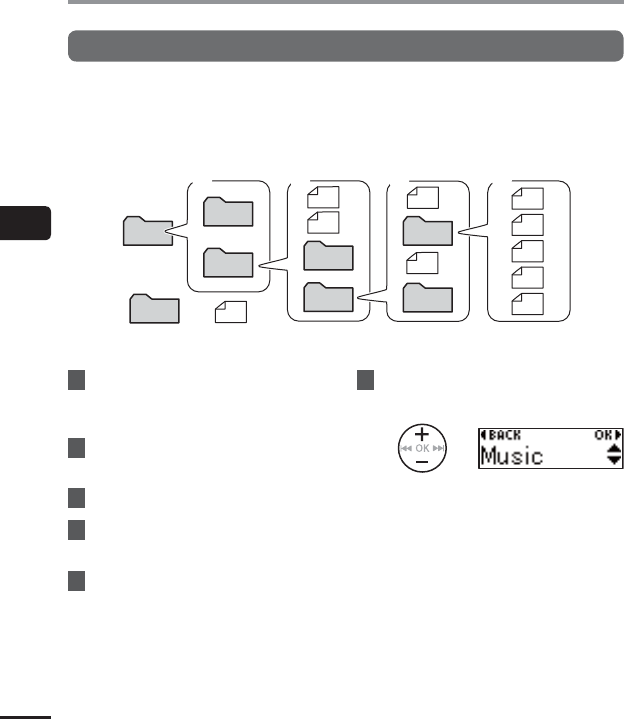
4
Changing the folder for playback [Play Folder]
52
EN
Changing the folder for playback [Play Folder]
You can switch the play folder to the [Recorder] folder containing the files recorded with the
built-in microphone or the [Music] folder containing music files and study content transferred
from a PC. The voice recorder can recognize folders up to the second level (C in the figure) in
the [Music] folder.
MUSIC
VP-10
RECORDER
A B C D
First level Second level Third level
Folder File
1
While the voice recorder is in stop
mode, press the
MENU
/
SCENE
button.
2
Press the
+
or
–
button to select
[
Play Menu
].
3
Press the
OK
button.
4
Press the
+
or
–
button to select
[
Play Folder
].
5
Press the
OK
button.
6
Press the
+
or
–
button to select
[
Recorder
] or [
Music
] (Fig. A).
[Recorder]:
Select this for playing files recorded
with the built-in microphone.
[Music]:
Select this for playing files transferred
from a PC.
• Press the 0 button to return to the
previous screen.
When [Recorder] was selected
☞Go to Step Ï
When [Music] was selec
ted
☞ Go to Step ‘
Changing the folder for playback [Play Folder]
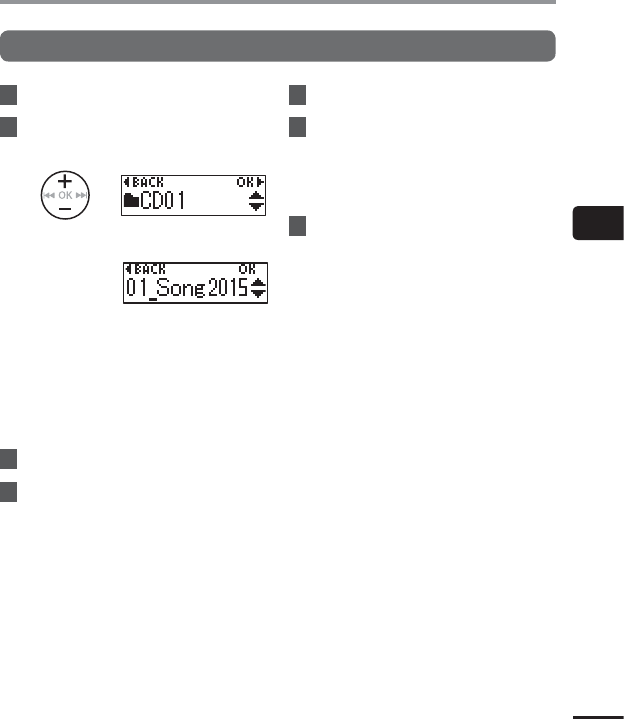
4
Changing the folder for playback [Play Folder]
53
EN
Changing the folder for playback [Play Folder]
Changing the folder for playback [Play Folder]
7
Press the
OK
button.
8
Press the
+
or
–
button to select
the file or sub folder (Fig. B).
When the sub folder was
selected
When the file was selected
• Press the 0 button to return to the
previous screen.
When the file was selected
☞Go to Step Ï
When the sub folder was selected
☞ Go to Step «
9
Press the
OK
button.
10
Press the
+
or
–
button to select
the file or sub folder (Fig. C).
When the file was selected
☞Go to Step Ï
When the sub folder was selected
☞ Go t
o Step Í
11
Press the
OK
button.
12
Press the
+
or
–
button to select
the file (Fig. D).
• The voice recorder cannot recognize
any folders at the third level (D in the
figure) in the [Music] folder.
13
Press the
OK
button to finalize
the setting.
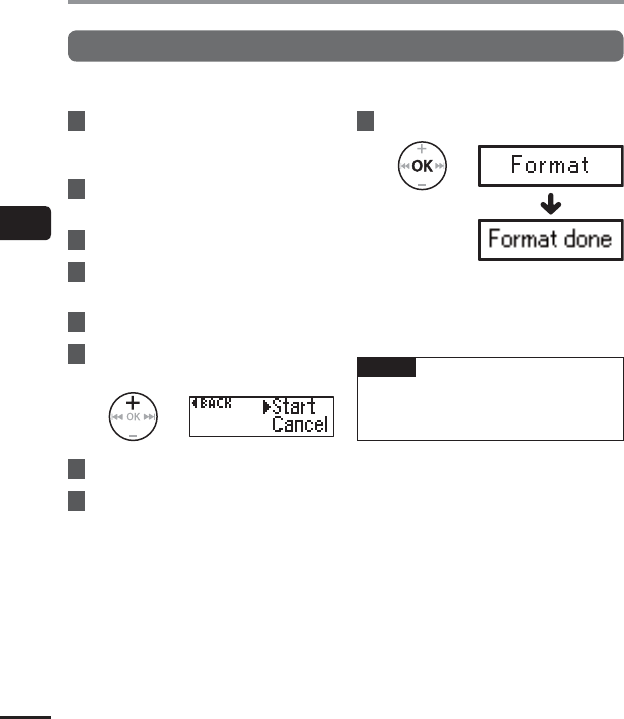
4
Formatting the internal memory [Format]
54
EN
Formatting the internal memory [Format]
Formatting the internal memory erases all existing files saved on it.
1
While the voice recorder is in stop
mode, press the
MENU
/
SCENE
button.
2
Press the
+
or
–
button to select
[
Device
].
3
Press the
OK
button.
4
Press the
+
or
–
button to select
[
Format
].
5
Press the
OK
button.
6
Press the
+
button to select
[
Start
].
7
Press the
OK
button.
8
Press the
+
button again to select
[
Start
].
9
Press the
OK
button.
• [Format] is displayed when formatting
starts.
• When [Format done] is displayed,
formatting is completed.
TIP
• P
erform [Reset Settings] to return
various functions to the factory default
(☞P.48).
Formatting the internal memory [Format]

4
Formatting the internal memory [Format]
55
EN
Formatting the internal memory [Format]
Formatting the internal memory [Format]
NOTE
• Nev
er format the voice recorder from a PC.
• Formatting erases all the existing data, including locked files and read-only files.
• Before formatting, charge or replace the battery to ensure it will not run out before
the process is finished. The formatting process can sometimes take over 10 seconds
to complete. To prevent the risk of damage to data, never remove the battery before a
formatting process has finished: Doing so may damage the data.
• Even when formatting or erasing (☞P.33) is performed, only the file management
information of the internal memory is updated and the recorded data is not completely
erased. Before giving the voice recorder to somebody or disposing of it, perform
initialization and then record silence until there is no recording time remaining in order to
prevent the leakage of personal information.
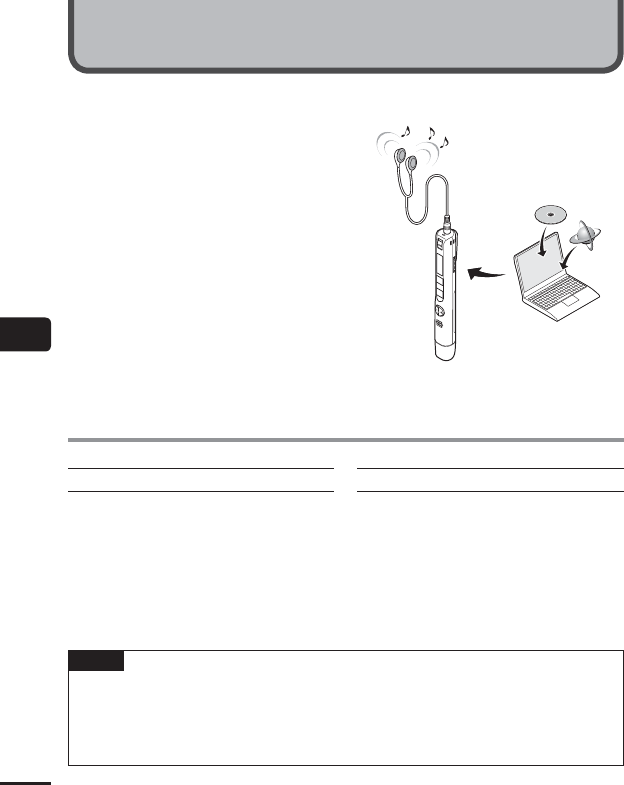
5
PC operating environment
56
EN
When connecting the voice recorder to a PC you can do the following:
• You can enjoy language content or music
files in WMA, MP3 and WAV format stored
on your PC (☞ P.64).
• Use the voice recorder as external storage
to save or load data to/from your PC
(☞ P.63).
Earphones are not supplied with this product.
PC operating environment
Windows
Operating system:
Microsoft Windows Vista/7/8, 8.1 standard
installation
PC:
Windows PC with at least one available
USB port
Macintosh
Operating system:
Mac OS X 10.5 to 10.9 standard installation
PC:
Apple Macintosh series PC with at least
one available USB port
NOTE
• T
he requirements shown are the operating environments needed for using a USB
connection to save files recorded by the voice recorder on a PC.
• Even when the requirements for the operating environment are satisfying, updated
versions, multi-boot environments, self-modified PCs and other compatible machines will
not be covered under the operational warranty.
Use with a PC

5
PC operating environment
57
EN
PC operating environment
PC connection precautions
• When uploading or downloading a file to or from the voice recorder, data transfer will
continue as long as the voice recorder’s LED indicator light is flashing, even if the PC
data communication screen disappears. Never disconnect the USB connector before
data communication has finished. Always use the procedure on ☞P.60 to disconnect
the USB connector. Data may not be transferred correctly if you disconnect the
connector before the drive has stopped.
• Do not format (initialize) the voice recorder’s drive from a PC. Formatting done from
a PC will not be done correctly. To perform formatting, use the [Format] menu of the
voice recorder (☞P.54).
• Voice recorder folders or files that are moved or renamed in a Windows or Macintosh file
management screen may be reordered or become unrecognizable.
• Note that it will still be possible to read and write data on the voice recorder after
setting the attribute of the voice recorder’s drive to ’Read only’ on a PC.
• To prevent nearby electronic devices being affected by noise, disconnect the earphones
when connecting the voice recorder to a PC.

5
PC connection/disconnection
58
EN
Connecting the voice recorder to a PC
1
Start the PC.
2
Remove the USB connector cover.
1
2
Slide open the USB connector cover using the
pad of your finger
3
After making sure the voice
recorder is stopped, connect the
USB connector to a USB port on a
PC.
When you use an Olympus nickel-
metal hydride rechargeable battery:
• To charge the battery, press the OK
button.
• To cancel the battery charging, press
the any button other than OK.
• While connected to USB, [Remote] is
displayed on the voice recorder.
• You can transfer files to the PC while
charging the recorder.
TIP
• W
indows: The voice recorder is
recognized and displayed in the [My
Computer] folder with the model
name as the drive name.
• Macintosh: The voice recorder is
recognized and displayed on the
desktop with the model name as the
drive name.
• For information on the PC’s USB port,
see the PC’s user manual.
• Use the USB extension cable provided
if needed.
PC connection/disconnection

5
PC connection/disconnection
59
EN
PC connection/disconnection
Connecting the voice recorder to a PC
NOTE
• T
he voice recorder must not be in
HOLD mode.
• Insert the USB connector securely all
the way. Operation will not be normal if
the connection is not made properly.
• Connecting the voice recorder through
a USB hub may result in unstable
operation. Do not use a USB hub if
operation is unstable.
• Use only a compatible Olympus USB
extension cable. Operation is not
guaranteed if another manufacturer’s
cable is used. Also, never use this
dedicated cable with any other
company’s products.

5
PC connection/disconnection
60
EN
PC connection/disconnection
Disconnecting the voice recorder from a PC
Windows
1
Click [ ] on the task bar in the
lower right hand corner of the
screen and click [
Eject DIGITAL
VOICE RECORDER
].
• The letter used to identify the drive
will vary according to your PC.
• When the window indicating it is safe
to remove hardware appears, close the
window.
2
Check that the LED indicator light
of the voice recorder has stopped
blinking and then disconnect the
USB cable.
Macintosh
1
Drag-and-drop the removable
disk icon for the voice recorder
shown on the desktop to the
trash can icon.
2
Check that the LED indicator light
of the voice recorder has stopped
blinking and then disconnect the
USB cable.
TIP
• Y
ou can disconnect the USB cable and use the voice recorder before the battery is fully
charged.
NOTE
• T
o prevent the risk of data damage, never disconnect the voice recorder from the USB
port while the LED indicator light is flashing.
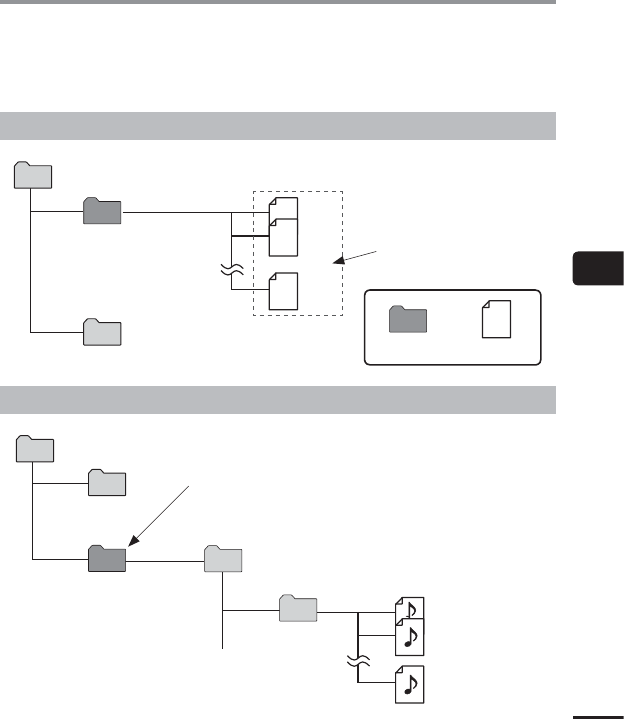
5
Loading a le to a PC
61
EN
Files recorded with the built-in microphone are saved in a folder named [RECORDER] on the
PC. You can copy voice recorder files to any folder on the PC.
4 Voice recorder drive name and folder names on the PC
Copying files recorded with the built-in microphone to a PC
VP-10
REC
ORDER
Recordings made with
the microphone are
saved here.
MUSIC
001
002
999
Folder File
The folder can store up to 999 files.
Copy these files to the PC.
Transferring music files and study content
VP-10
MUSIC
RECORDER
Place the files to be transferred from
the PC into this folder.
First level
Second level
001
002
999
Artist 01
Album 01
Each folder can store up to
999 files.
Loading a file to a PC
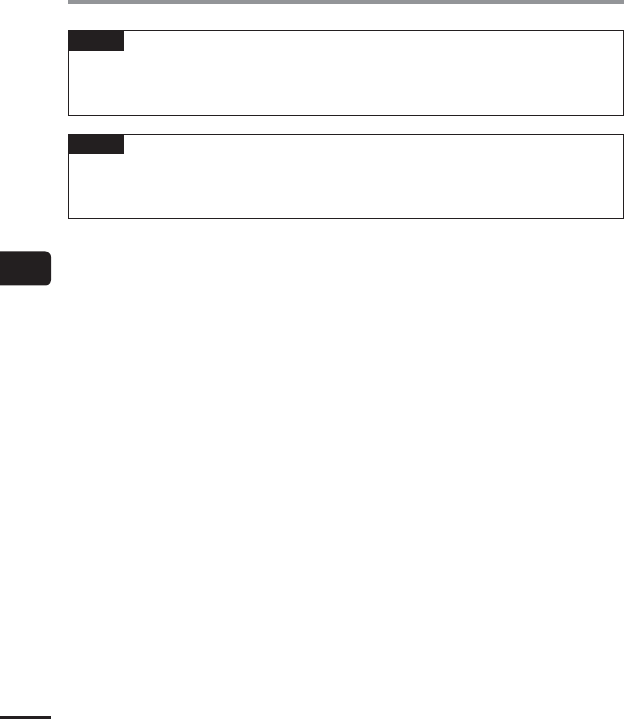
5
Loading a le to a PC
62
EN
Loading a file to a PC
TIP
• Up t
o 130 folders can be created within the [Music] folder (including a [Music] folder
itself).
• The voice recorder can only recognize two folder sublevels.
NOTE
• T
o prevent the risk of data damage, never disconnect the voice recorder from the USB
port while the LED indicator light is flashing.
• WMA-format files cannot be played in the standard Macintosh operating system.

5
Usage as external memory of the PC
63
EN
Connecting the voice recorder to a PC lets you transfer voice recorder data to save in the PC,
and vice-versa.
Windows
1
Connect the voice recorder to the
PC (☞P.58).
2
Open Windows Explorer.
• When you open [My Computer], the
voice recorder is recognized by the
drive letter that includes the product
name.
3
Click on the folder labeled with
your voice recorder’s model
name.
4
Copy the desired data to the PC.
5
Disconnect the voice recorder
fr
om the PC (☞P.60).
Macintosh
1
Connect the voice recorder to the
PC (☞P.58).
• When connected to a Mac OS, the
voice recorder is recognized on
the desktop by the drive letter that
includes the product name.
2
Double-click the removable disk
icon labeled with your voice
recorder’s model name.
3
Copy the desired data to the PC.
4
Disconnect the voice recorder
fr
om the PC (☞P.60).
NOTE
• During data c
ommunication, [Busy] appears in the voice recorder’s display and the LED
indicator light flashes. To prevent the risk of data damage, never disconnect the voice
recorder from the USB port while the LED indicator light is flashing.
Usage as external memory of the PC

5
Listening to les transferred from a PC
64
EN
To listen a transferred file
You can listen to music files, study content, etc. transferred from a PC.
NOTE
• C
onnect the voice recorder to a PC
and transfer the music files and study
content to the [Music] folder of the
voice recorder beforehand (☞P.61).
• The voice recorder cannot recognize
any folders at the third level in the
[Music] folder.
1
Select the desired file to
playback.
• Use the [Play Folder] menu function
to switch to the [Music] folder and
then select the file (☞P.52).
2
Press the `
PLAY
/4
STOP
button to
start playback.
3
Press the
+
or
–
button to adjust
the volume to the desired level.
4
Press the `
PLAY
/4
STOP
button to
stop playback.
Listening to files transferred from a PC
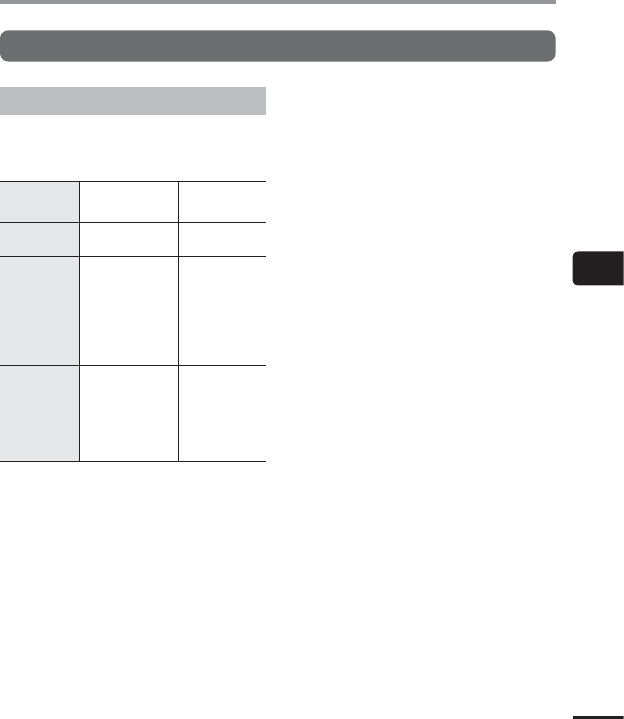
5
Listening to les transferred from a PC
65
EN
Listening to files transferred from a PC
To listen a transferred file
Playable files
The sampling rate, bit count and bit rate
combinations supported for file playback are
shown below.
File format Sampling rate
Bit count/bit
rate
WAV format
22.05 kHz,
44.1 kHz
16 bits
MP3 format
MPEG 1 Layer 3:
32 kHz,
44.1 kHz,
48 kHz
MPEG 2 Layer 3:
16 kHz,
22.05 kHz,
24 kHz
8 to 320 kbps
WMA format
8 kHz,
11 kHz,
16 kHz,
22 kHz,
32 kHz,
44.1 kHz,
48 kHz
5 to 320 kbps
• MP3 files with variable bit rates (bit rates
converted variably in a single file) may not
play normally.
• Linear PCM-format WAV files are the only
WAV files the voice recorder can play.
Playback of other WAV files is not supported.
• Even if the file formats is compatible for
playback on this recorder, the recorder does
not support every encoder.
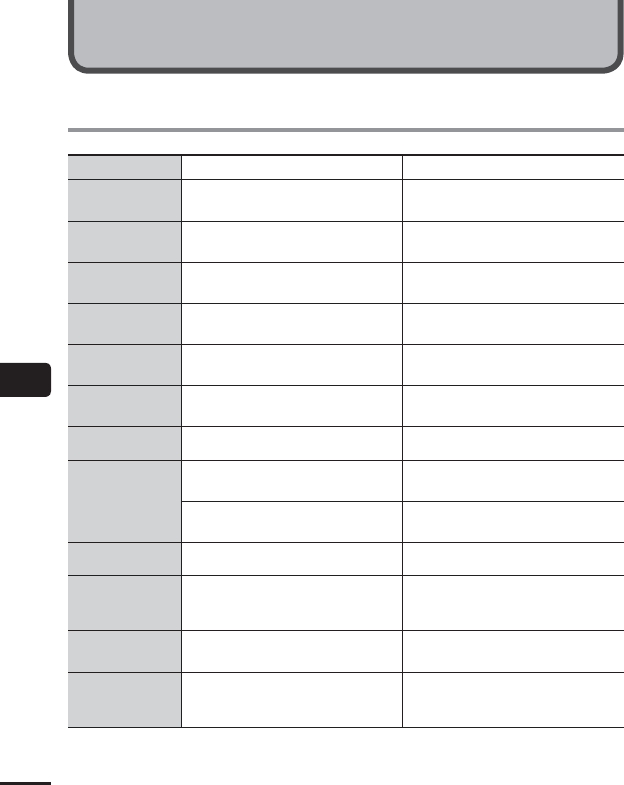
6
Alarm message list
66
EN
Alarm message list
Message Meaning Action required
Battery Low The remaining battery power is low.
Replace or charge the battery
(☞P.7, P.10).
File Locked The File is locked.
You must unlock the file before you can
erase it (☞P.37).
Index Full
The maximum number of index marks
(99) have been written in the file.
Erase unneeded index marks (☞P.29).
Temp Full
The maximum number of temp marks
(99) have been written in the file.
Erase unneeded temp marks (☞P.29).
Folder Full
The maximum number of files (999) have
been saved in the folder.
Erase unneeded files (☞P.33).
Mem. Error An internal memory error occurred.
Contact the Olympus Customer Support
Center (☞back cover).
Memory Full There is no remaining memory.
Erase unneeded files (☞P.33).
No File
There are no files in the folder.
Record a new file, or select another folder
(☞P.16, P.53).
No file has been selected.
You must select a file before you can
perform the operation (☞P.23, P.64).
Format Err A formatting problem occurred.
Format the memory again (☞P.54).
Sysfile Err
The voice recorder is unable to create a
management file due to low remaining
memory.
Connect the voice recorder to a PC and
erase unneeded files.
Cannot Play The file’s format is not supported.
Select a file that can be played by the
voice recorder (☞P.65).
File Error
An attempt was made to divide a file
that is not an MP3- or WAV-format file
recorded by the voice recorder.
Select another file.
Other information
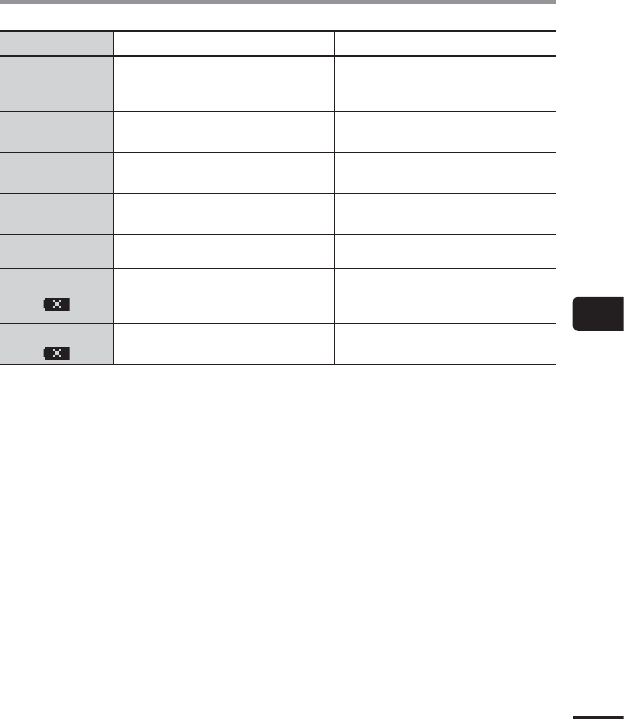
6
Alarm message list
67
EN
Alarm message list
Message Meaning Action required
Pos Error
An attempt was made to divide a file at a
position where dividing is not possible.
It may not be possible to divide some
MP3 or PCM files with extremely short
recording times (☞P.50).
Noise Off [Noise Cancel] function is enabled.
[Noise Cancel] function turns off
automatically (☞P.41).
Scene Off
[Rec Scene] or [Play Scene] function is
enabled.
[Rec Scene] or [Play Scene] function
turns off automatically (☞P.20, P.27).
x 1.0 Play
The playback speed function is set to
other than [x1.0].
The playback speed function returns to
[x1.0] automatically (☞P.28).
Power Error A bus power error occurred.
Cancel the USB connection (☞P.60).
can't charge
(
)
An attempt was made to charge an AAA
alkaline battery or a rechargeable battery
other than one specified.
Use an Olympus nickel-metal hydride
rechargeable battery (BR404).
can't charge_2
(
)
A bus power error occurred.
Cancel the USB connection (☞P.60).
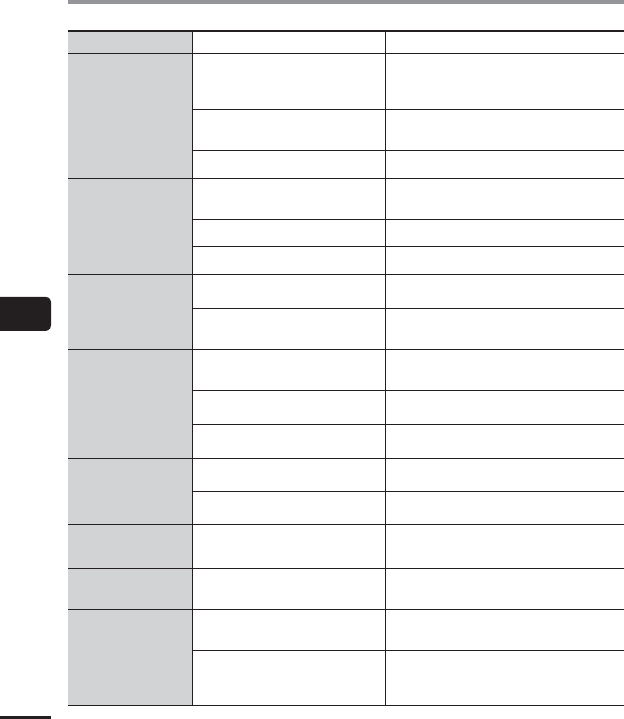
6
Troubleshooting
68
EN
Problem Possible cause Solution
The display is blank.
The battery is not inserted properly.
Check that the positive and negative
terminals of the battery are placed correctly
(☞P.7).
The remaining battery power is low.
Replace or charge the battery
(☞P.7, P.10).
The power is OFF.
Turn the power ON (☞P.8).
Unable to operate
the voice recorder
The remaining battery power is low.
Replace or charge the battery
(☞P.7, P.10).
The power is OFF.
Turn the power ON (☞P.8).
The voice recorder is in HOLD mode.
Release HOLD mode (☞P.30).
Unable to record
There is no remaining memory.
Erase unneeded files (☞P.33).
The maximum number of
recordable files has been reached.
Erase unneeded files (☞P.33).
Playback is
inaudible.
The earphones are connected to
the earphone jack.
To output the playback through the built-in
speaker, disconnect the earphones.
[OFF] has been selected for
[Speaker].
To output the playback through the built-in
speaker, select [ON] for [Speaker] (☞P.45).
The volume is set to [00].
Adjust the volume (☞ P.23).
The recording is too
quiet.
[Low] has been selected for
[Rec Level].
Redo recording after setting the
recording level to [High] (☞ P.38).
The voice recorder is far away from
the recording target.
Move the voice recorder closer to the
recording target.
Audio file sound is
distorted.
The recording level is adjusted
automatically. Excessively loud
sound input may generate noise.
Record with the voice recorder farther away
from the recording target.
An audio file is not
recorded in stereo.
[Rec Mode] is set to a mono
recording format (WMA).
Set [Rec Mode] to a stereo recording format
(PCM or MP3) (☞
P.38).
Noise during
pla
yback
Objects brushed against the voice
recorder while recording.
------------------
The voice recorder was placed near
a mobile phone or fluorescent light
during recording or playback.
Redo the operation with the voice recorder in
a different location.
Troubleshooting
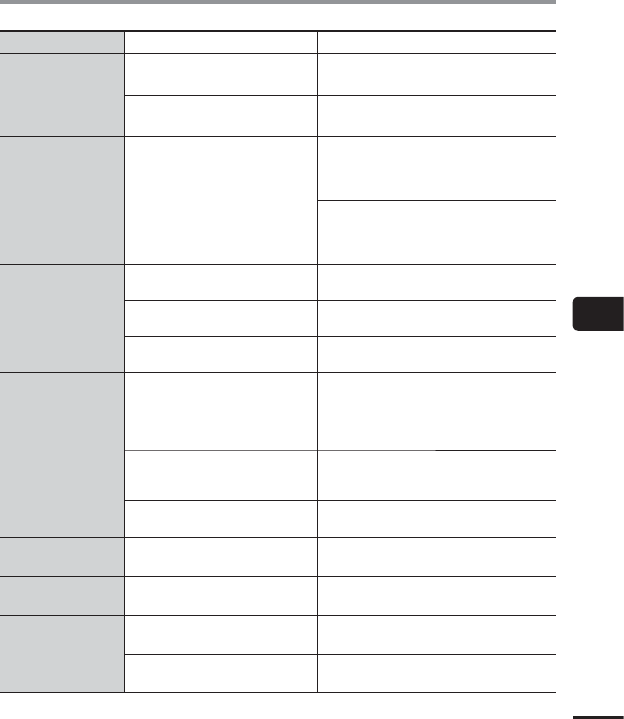
6
Troubleshooting
69
EN
Troubleshooting
Problem Possible cause Solution
Unable to erase
a file
The file is locked.
You must unlock the file before you can erase
it (☞P.37).
The file is a read-only file.
Unlock the file, or undo the read-only setting
on a PC.
Noise when
monitoring a
recording
Feedback is being caused.
Connecting a speaker with a built-in amplifier
may cause feedback during recording.
It is recommended that you use earphones
before starting recording (☞ P.19).
Adjust the recording setup such as by
moving the earphones and microphone
farther apart, or ensuring the microphone is
not facing the earphones.
Unable to write
index marks/temp
marks
The maximum number of marks (99)
has been reached.
Erase unneeded marks (☞P.29).
The file is locked.
You must unlock the file before you can erase
it (☞P.37).
The file is a read-only file.
Unlock the file, or undo the read-only setting
on a PC.
Unable to charge
the battery
[Alkaline] has been selected for
[Battery].
To use the rechargeable battery provided,
select [Ni-MH] for [Battery]. Do not use
the rechargeable battery at higher/lower
temperatures than the recommended range
(☞ P.8, P.13, P.46).
The OK button was not pressed.
Press the OK button as directed in the
confirmation screen shown when connecting
the USB connector.
The voice recorder is in HOLD mode.
Release HOLD mode (☞P.30).
Button operations
are abnormal.
[Play Scene] function is enabled.
Set the [Play Scene] setting to [OFF]
(☞ P.27).
Playback speed is
fast (or slow).
Playback speed function is set to
anything other than [x1.0].
Set the playback speed function setting to
[x1.0] (☞ P.28).
Files cannot
be played
consecutively.
[File] has been selected for
[Playback Range].
Set the [Playback Range] setting to [Folder]
(
☞ P
.41).
[ON] has been selected for [Repeat].
Set the [Repeat] setting to [OFF] (☞ P.42).
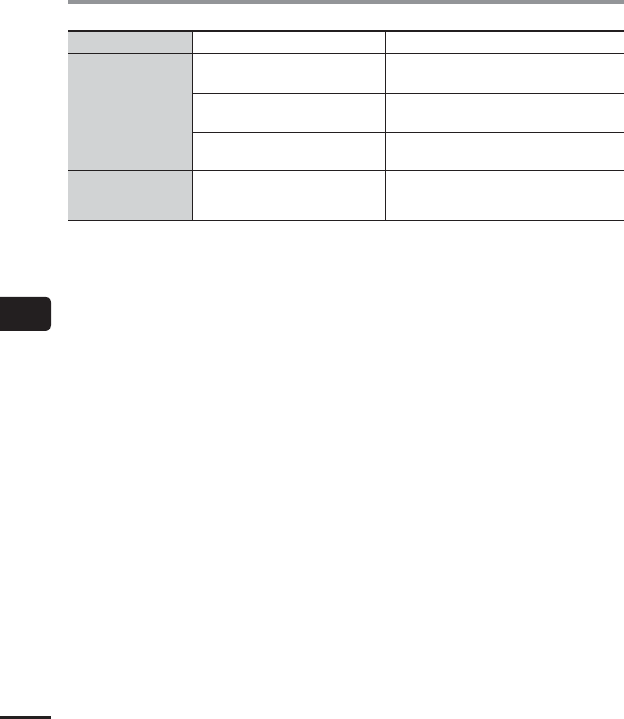
6
Troubleshooting
70
EN
Troubleshooting
Problem Possible cause Solution
Unable to skip to the
next or previous file
during playback
[File] has been selected for
[Playback Range].
Set the [Playback Range] setting to [Folder]
(☞P.41).
[ON] has been selected for [Repeat].
Set the [Repeat] setting to [OFF] (☞P.42).
The [Skip Space] is set to other than
[File Skip].
Set the [Skip Space] setting to [File Skip]
(☞P.42).
When files are
switched, playback
starts automatically.
[ON] has been selected for
[Intro Play].
Set the [Intro Play] setting to [OFF]
(☞P.45).
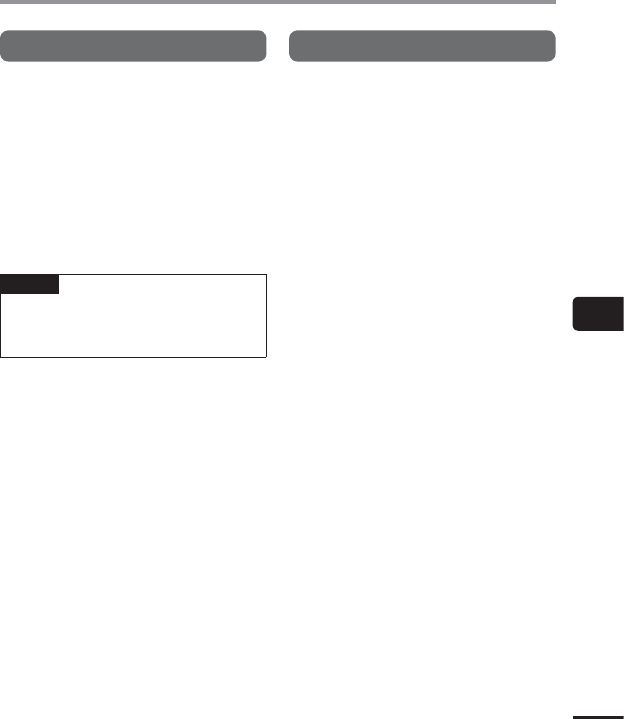
6
Other
71
EN
Recorder care
s Exterior
Wipe gently with a soft cloth. If the
recorder is very dirty, soak the cloth in
mild soapy water and wring well. Wipe the
recorder with the damp cloth and then
wipe it with a dry cloth.
s Display
Wipe gently with a soft cloth.
NOTE
• Do not use benz
ene, alcohol or other
strong solvents, or chemical cleaning
cloths.
Accessories (optional)
BR404 nickel-metal hydride AAA
rechargeable battery
A high-efficiency, long-lasting
rechargeable battery.
A514 USB-connection AC adapter
A USB-connected AC adapter that
provides 5-volt DC output. (AC100-240V
50/60Hz)
Other

6
Copyright and trademark information
72
EN
• The information in this document is subject to change in future without prior notice. Contact
Olympus Customer Support Center for the latest product names, model numbers and other
information.
• The display and illustrations of the voice recorder used in this manual may different from
the actual product. While every precaution has been taken to ensure the accuracy of
the information in this manual, errors may occasionally arise. Any questions or concerns
regarding doubtful information, or possible errors or omissions should be directed to the
Olympus Customer Support Center.
• Olympus Corporation is the copyright holders of this manual. Copyright law prohibits
unauthorized reproduction of this manual, or unauthorized distribution of reproductions
thereof.
• Note that Olympus will assume no liability in the event of damages, lost earnings, or any
claims from third parties resulting from improper use of the product.
Trademarks and registered trademarks
• IBM and PC/AT are trademarks or registered trademarks of International Business Machines
Corporation.
• Microsoft, Windows and Windows Media are registered trademarks of Microsoft Corporation.
• Macintosh and iTunes are trademarks of Apple Inc.
• The product uses MP3 audio coding technology licensed from Fraunhofer IIS and Thomson.
• Manufactured under license of R-Talk library from NTT AdvancedTechnology Corporation.
R-Talk is registered trademark or a trademark of NTT Advanced Technology Corporation in
Japan and other countries.
1 In regard to the VP-10, you are only permitted non-exclusive use of R-Talk library.
2 You may not duplicate R-Talk library.
3 You may not modify R-Talk library.
4 You may not engage in reverse engineering, decompilation or disassembly of R-Talk library.
5 You may not sublicense, assign, lease, or transfer possession of R-Talk library to third parties.
6 Nippon Telegraph and Telephone Corporation retain all copyrights and other intellectual property rights
(excluding trademarks) of R-Talk library.
All other brand or product names in this manual are the trademarks or registered trademarks of
their respective owners.
Copyright and trademark information

6
Safety precautions
73
EN
Before using the voice recorder, read
this manual to ensure correct and safe
operation. After reading this manual, be
sure to keep it on hand for ready reference
whenever needed.
Important safety precautions
• Important items about safety are indicated
by the following display and sentences.
Always follow these precautions to
prevent harming yourself or others, or
causing damage to property.
• The meaning of each precaution type is
given below.
f DANGER
A precaution about an imminent
danger that is expected to result in
death or serious injury if equipment is
handed incorrectly.
f WARNING
A precaution about a situation that
is expected to potentially result in
death or serious injury if equipment is
handled incorrectly.
f CAUTION
A precaution about a situation that
is expected to potentially result in
injury, or is expected to result only
in property damage, if equipment is
handled incorrectly.
Voice recorder safety precautions
f WARNING
s Do not use the voice recorder in
an atmosphere that might contain
flammable or explosive gases.
It may cause fire or explosion.
s Do not attempt to disassemble,
repair or modify the voice recorder.
It may cause electric shock or injury.
s Do not operate the voice recorder
while operating a vehicle (such as a
bicycle, motorcycle or car).
It may cause traffic accidents.
s Do not leave the voice recorder in
a location accessible to an infant
or child.
Pay attention when using the voice
recorder near an infant or child, taking
care not to leave it unattended. Infants
and children are unable to understand
voice recorder safety precautions, and are
at risk of accidents such as:
− Strangulation caused by accidental
entanglement of the earphone cord
around the neck.
− Operation errors resulting in injury or
electric shock.
s If the voice recorder is dropped
in water or, if water, metal or
combustible foreign matter gets
inside:
1 Remove the battery immediately.
2 Contact your place of purchase or
an Olympus service center for repair.
Continued use may result in fire or
electric shock.
Safety precautions

6
Safety precautions
74
EN
Safety precautions
s Do not use the voice recorder or
use it only as directed in airplanes,
hospitals or other locations
where use of electronic devices is
restricted.
s Stop using the voice recorder if
you notice unusual odor, noise, or
smoke coming from it.
It may cause fire or burns. Remove the
battery immediately, taking care not
to burn yourself. Contact your place of
purchase or an Olympus repair center or
service center. (Do not touch the battery
with bare hands when removing it.
Remove the battery outdoors, and away
from flammable objects.)
f CAUTION
s Do not raise the volume before
performing an operation.
Hearing damage or loss may result.
Batteries
f DANGER
s Do not place the battery near
ignition sources.
s Do not incinerate, heat or
disassemble the battery. Do not
short-circuit the battery’s positive
and negative electrodes.
It may cause fire, ruptures, combustion or
overheating.
s Do not solder connections directly
onto the battery. Do not deform,
modify or disassemble the battery.
s Do not connect the battery’s
positive and negative terminals.
It may cause overheating, electric shock
or fire.
s When carrying or storing the
battery, always place it in the case
to protect its terminals. Do not
carry or store the battery together
with precious metal items such as
key rings.
It may cause overheating, electric shock
or fire.
s Do not connect the battery directly
to a power outlet or car cigarette
lighter.
s Do not use or leave the battery
in a hot location such as in direct
sunlight, inside a vehicle on a hot
day, or near a room heater.
It may cause fire, burns or injuries from
leaking, overheating or ruptures.
f WARNING
s Do not touch or hold the battery
with wet hands.
It may cause electric shock or
malfunctions.
s Do not use a battery with a
scratched or damaged case.
It may cause ruptures or overheating.

6
Safety precautions
75
EN
Safety precautions
s Do not insert the battery with its
positive/negative terminals in the
opposite direction.
It may cause leaking, overheating,
combustion or ruptures.
• Do not use a battery with a torn casing
seal (insulating covering).
• Always remove the battery when the
voice recorder will not be used for an
long period.
• When disposing used batteries, insulate
their contacts with tape and discard
them as general waste in the manner
prescribed by the local authority.
• Remove the battery from the voice
recorder as soon as the battery
becomes unusable. It may cause
leakage.
s Battery fluid in the eyes may cause
blindness. If battery fluid gets in
eyes, do not rub the eyes. Instead,
rinse them thoroughly with tap
water or other clean water right
away. Go to doctor immediately.
s Do not attempt to recharge
alkaline, lithium or any other non-
rechargeable batteries.
s Keep the battery out of the reach
of infants and children.
The battery could be swallowed by an
infant or child. If swallowed, go to doctor
immediately.
s If you notice abnormal sound,
heat, burning odor or smoke from
the voice recorder during use:
1 Remove the battery immediately,
taking care not to injure yourself.
2 Have the voice recorder repaired by
your place of purchase or an Olympus
service center. Continued use may
result in fire or burns.
s Do not submerge the battery in
freshwater or saltwater, or allow its
terminals to become wet.
s Discontinue use of the battery
if it develops a problem such
as leaking, discoloration or
deformation.
s Stop charging the rechargeable
battery if charging has not finished
after the specified amount of
charging time.
s Battery fluid on clothing or skin
may damage the skin, so rinse the
battery fluid off right away with
tap water or other clean water.
f CAUTION
s Do not throw the battery around,
or subject it to strong shocks.
s Always charge the rechargeable
battery before use when using
it for the first time or if it has not
been used for a long time.
s Rechargeable batteries have a
limited life. When the recorders
operating time becomes shorter
after recharging under the speci-
fied condition, please consider
that battery is expired and replace
it with a new one.

6
Safety precautions
76
EN
Safety precautions
Disposing the rechargeable
battery
s Recycling batteries helps saving
resources. When disposing a used
battery, always cover its terminals
and observe local laws and
regulations.
Operating precautions
• Do not leave the voice recorder in hot or
humid locations such as in direct sunlight
inside a vehicle, or on a beach during
summer.
• Do not store the voice recorder in humid
or dusty locations.
• If the voice recorder becomes wet or
damp, wipe off the moisture right away
with a dry cloth. Contact with salt water
should be particularly avoided.
• Do not place the voice recorder on top of
or near a TV, refrigerator or other electrical
appliance.
• Prevent sand or mud from getting on the
voice recorder. It may cause product not to
be repairable.
• Do not subject the voice recorder to
intense vibrations or shocks.
• Do not use the voice recorder in humid
locations.
• Placing a magnetic card (such as a bank
cash card) near the speaker or earphones
may cause errors in the data stored on the
magnetic card.
<Data loss precautions>
• Recorded content in the internal memory
may be destroyed or lost due to reasons
such as operating errors, device failure or
repair.
• Also, when content is saved in the memory
for long period of time or is used repeatedly,
operations such as writing to, reading from,
or erasing of contents may not be possible.
• Making a backup of important recorded
information and saving it on a PC’s hard disk
or other recording media is recommended.
• Note that Olympus will assume no liability
for damages or lost earnings resulting from
recorded data damage or loss, regardless of
the nature or cause thereof.
<Recorded file precautions>
• Note that Olympus will assume no
liability for recorded files being erased
or becoming unplayable due to voice
recorder or PC failure.
• Recording of copyrighted material is
permitted when the recording is for your
personal use only. Any other type of use
without the permission of the copyright
owner is prohibited by copyright law.
<Voice recorder disposal precautions>
• Even when formatting (☞ P.54) or
erasing (☞ P.33)are performed, only
the file management information of the
internal memory is updated and the
recorded data is not completely erased.
When disposing the voice recorder, be
sure to destroy it, format and record
silence until the recording time runs
out, or perform a similar operation in
order to prevent the leakage of personal
information.
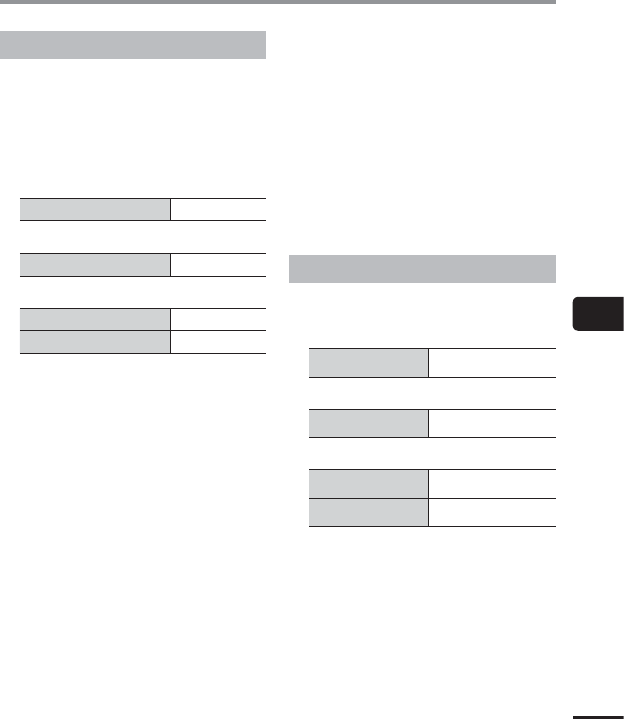
6
Speci cations
77
EN
General items
4 Recording formats
Linear PCM (pulse-code modulation)
format
MP3 (MPEG-1 Audio Layer 3) format
WMA (Windows Media Audio) format
4 Sampling frequency
Linear PCM format
22.05 kHz/16 bits 22.05 kHz
MP3 format
128 kbps 44.1 kHz
WMA format
32 kbps mono 44.1 kHz
5 kbps mono 8 kHz
4 Maximum working output
90 mW (8 Ω speaker)
4 Maximum headphone output
â
1
50 mV (conforms to EN 50332-2)
4 Recording media*
Internal NAND FLASH memory: 4 GB
* Some memory capacity is used as
a management area, so the actual
usable capacity will always be slightly
less than the displayed capacity.
4 Speaker
Built-in ø 10 mm round dynamic speaker
4 Earphone jack
ø 3.5 mm impedance 8 Ω or more
Specifications
4 Power source
Standard voltage: 1.5 V
Battery: One AAA dry cell battery (model
LR03), or one Olympus nickel-metal
hydride rechargeable battery
4 External dimensions
17 mm × 130 mm × 17 mm
(Not including largest projection)
4 Weight
37.5 g (including battery)
4 Operating temperature
0 to 42°C (32 to 107.6°F)
Frequency response
4 When recording with built-in
stereo microphone
Linear PCM format
22.05 kHz/16 bits 50 Hz to 10 kHz
MP3 format
128 kbps 50 Hz to 17 kHz
WMA format
32 kbps mono 50 Hz to 13 kHz
5 kbps mono 50 Hz to 3 kHz
4 During playback
20 Hz to 20 kHz
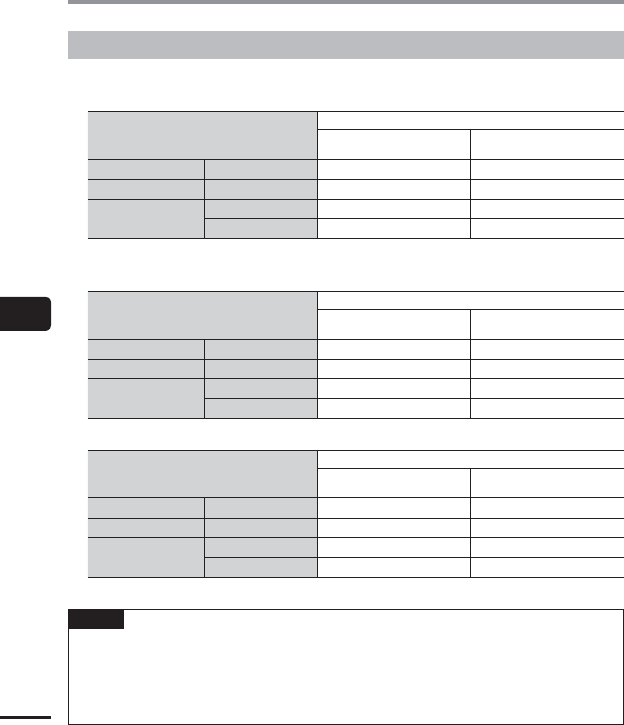
6
Speci cations
78
EN
Specifications
Battery life
The figures below are guideline values.
4 When recording with built-in stereo microphone (using internal memory)
Recording mode
Battery life
Alkaline dry cell battery
Nickel-metal hydride
rechargeable battery
Linear PCM format 22.05 kHz/16 bits 24 hours (approx.) 20 hours (approx.)
MP3 format 128 kbps 27 hours (approx.) 22 hours (approx.)
WMA format
32 kbps mono 33 hours (approx.) 26 hours (approx.)
5 kbps mono 50 hours (approx.) 38 hours (approx.)
4 During audio file playback (all playback modes)
During speaker playback
Recording mode
Battery life
Alkaline dry cell battery
Nickel-metal hydride
rechargeable battery
Linear PCM format 22.05 kHz/16 bits 19 hours (approx.) 16 hours (approx.)
MP3 format 128 kbps 21 hours (approx.) 18 hours (approx.)
WMA format
32 kbps mono 24 hours (approx.) 19 hours (approx.)
5 kbps mono 24 hours (approx.) 19 hours (approx.)
During earphone playback
Recording mode
Battery life
Alkaline dry cell battery
Nickel-metal hydride
rechargeable battery
Linear PCM format 22.05 kHz/16 bits 23 hours (approx.) 19 hours (approx.)
MP3 format 128 kbps 28 hours (approx.) 22 hours (approx.)
WMA format
32 kbps mono 29 hours (approx.) 23 hours (approx.)
5 kbps mono 29 hours (approx.) 23 hours (approx.)
NOTE
• T
he battery life figures shown here were determined using an Olympus test method
(When [LED] is set to [OFF]). Actual battery life figures will vary greatly according to the
battery used and usage conditions (Changing the playback speed, or using the [Noise
Cancel], [Voice Balancer], [Rec Scene], [Play Scene] and [Rec Standby] functions may
affect the battery life).
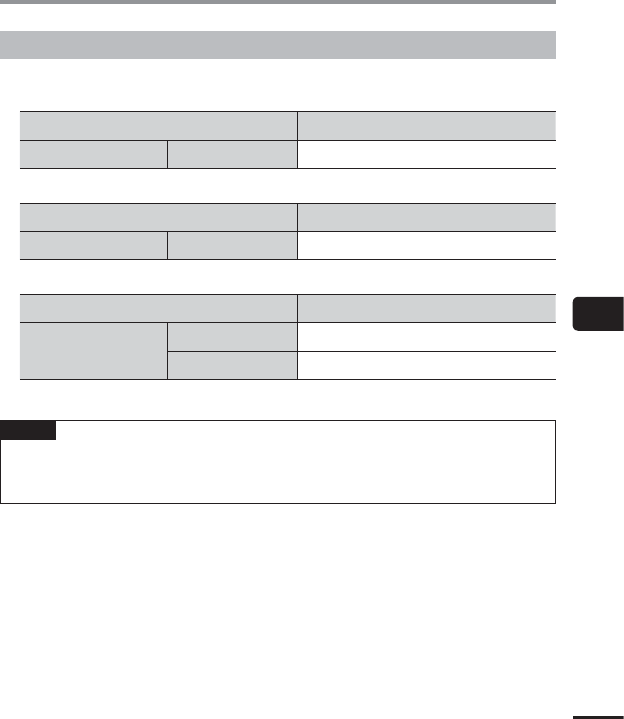
6
Speci cations
79
EN
Specifications
Recording time
The figures below are guideline values.
4 Linear PCM format
Recording mode Internal memory (4 GB)
Linear PCM format 22.05 kHz/16 bits 12 hours (approx.)
4 MP3 format
Recording mode Internal memory (4 GB)
MP3 format 128 kbps 66 hours (approx.)
4 WMA format
Recording mode Internal memory (4 GB)
WMA format
32 kbps mono 258 hours (approx.)
5 kbps mono 1620 hours (approx.)
NOTE
• A
ctually available recording times may be shorter than the figures shown here when
making short recordings repeatedly (Equipment displays of available/elapsed recording
times should be considered guideline values).
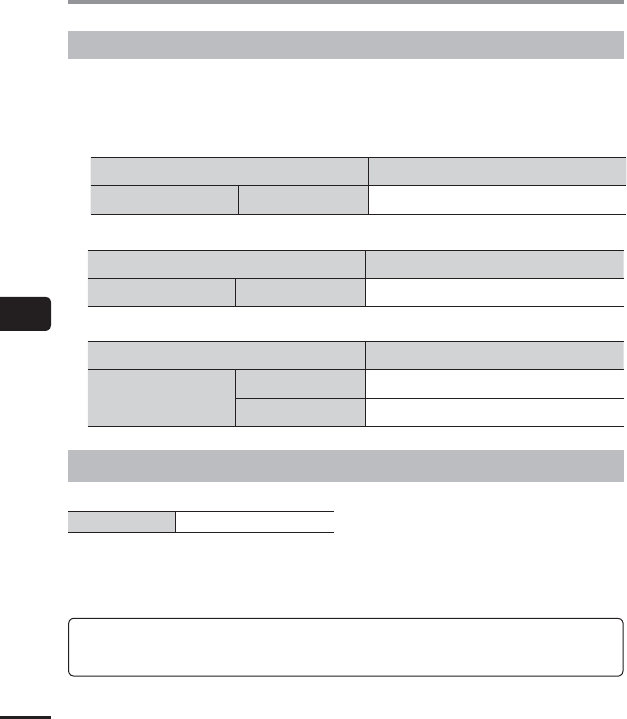
6
Speci cations
80
EN
Specifications
Maximum recording time per file
• The maximum file size is limited to about 4 GB in the MP3 format, and to about 2 GB in the
linear PCM (WAV) format.
• Regardless of the amount of remaining memory, the maximum recording time per file is
restricted to the following values.
4 Linear PCM format
Recording mode Recording time
Linear PCM format 22.05 kHz/16 bits 6 hours, 40 minutes (approx.)
4 MP3 format
Recording mode Recording time
MP3 format 128 kbps 66 hours (approx.)
4 WMA format
Recording mode Recording time
WMA format
32 kbps mono 26 hours, 40 minutes (approx.)
5 kbps mono 148 hours, 40 minutes (approx.)
Number of music tracks (songs) that can be recorded
The figures below are guideline values.
4 GB 800 tracks (approx.)
(At 128 kbps, 4 minutes per track)
Note that voice recorder specifications and appearance are subject to change without prior
notice for performance improvements or other upgrading.
For customers in North and South
America:
FCC Notice
• This equipment has been tested and
found to comply with the limits for a Class
B digital device, pursuant to Part 15 of
the FCC Rules. These limits are designed
to provide reasonable protection against
harmful interference in a residential
installation.
• This equipment generates, uses, and
can radiate radio frequency energy and,
if not installed and used in accordance
with the instructions, may cause harmful
interference to radio communications.
• However, there is no guarantee that
interference will not occur in a particular
installation. If this equipment does cause
harmful interference to radio or television
reception, which can be determined
by turning the equipment off and on,
the user is encouraged to try to correct
the interference by one or more of the
following measures:
- Reorient or relocate the receiving
antenna.
- Increase the separation between the
equipment and receiver.
- Connect the equipment into an outlet
on a circuit different from that to which
the receiver is connected.
- Consult the dealer or an experienced
radio/TV technician for help.
- Only the OLYMPUS-supplied USB
cable should be used to connect the
equipment to USB enabled personal
computers (PC).
Any unauthorized changes or modifications
to this equipment would void the user's
authority to operate.
For customers in USA
Declaration of Conformity
Model Number: VP-10
Trade Name: OLYMPUS
Responsible Party: OLYMPUS AMERICA INC.
Address: 3500 Corporate Parkway, P.O. Box
610, Center Valley, PA 18034-0610, U.S.A.
Telephone Number: 1-888-553-4448
Tested To Comply With FCC Standards
FOR HOME OR OFFICE USE
This device complies with Part 15 of the FCC
rules. Operation is subject to the following
two conditions:
(1) This device may not cause harmful
interference, and
(2) this device must accept any interference
received, including interference that may
cause undesired operation.
For customers in
CANADA
CAN ICES-3 (B)/NMB-3 (B)

OLYMPUS CORPORATION
2951 Ishikawa-machi, Hachioji-shi, Tokyo 192-8507, Japan.
OLYMPUS AMERICA INC.
3500 Corporate Parkway, P.O. Box 610, Center Valley, PA 18034-0610, U.S.A.
Tel. 484-896-5000
Technical Support (USA):
24/7 online automated help:
http://www.olympusamerica.com/
support
Phone customer support:
Tel.: 1-888-553-4448 (Toll-free)
Our phone customer support is available
from 9 am to 9 pm (Monday to Friday) ET
http://www.olympusamerica.com/
contactus
Olympus software updates can be
obtained at:
http://www.olympusamerica.com/digital
EN-BD4114-01 AP1412
